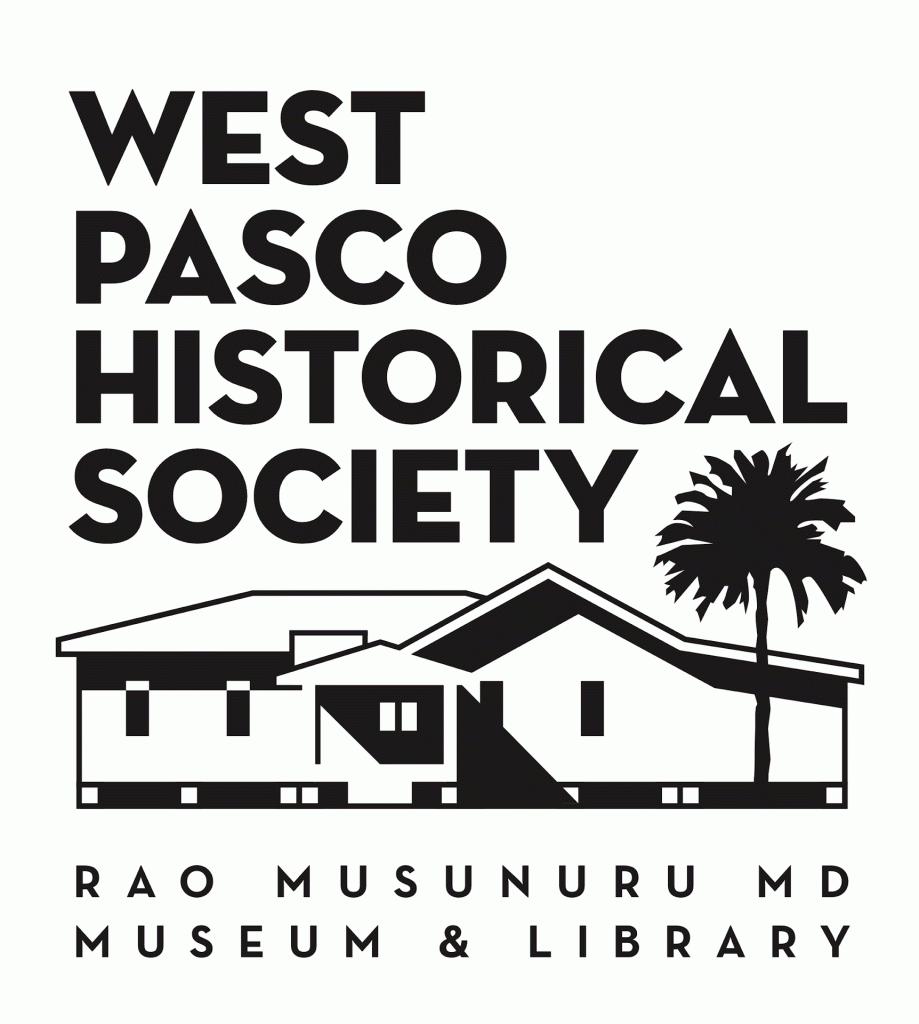HISTORY OF TARPON SPRINGS, FLORIDAHistory of Tarpon SpringsAbout the Author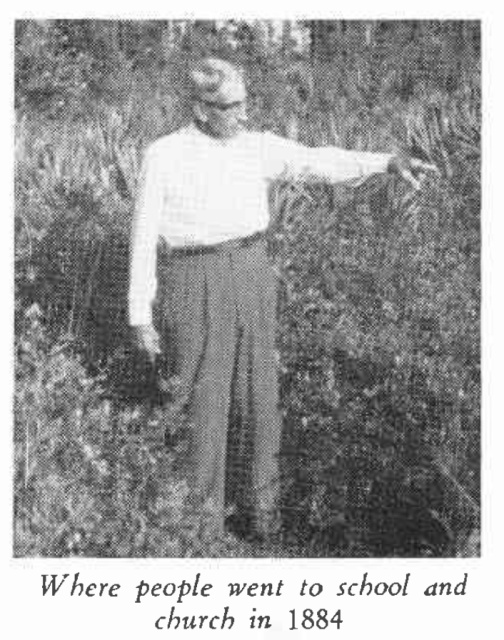 As a minister it is not only a distinct honor but a most wonderful privilege of mine to be Mr. Pent’s pastor. Having Mr. Pent as a member of my congregation is one of the most rewarding and inspiring experiences of my life. The author of this book is a very sincere and devout Christian who loves his neighbor, his church, and delights in the truth. Mr. Pent has not endeavored, in this volume, to set forth a textbook as such, but in plain straight forwardness has given us the story of Tarpon Springs, a lovely little city on the West Coast of Florida. Having been born in Tarpon Springs in the year of 1878, and still residing there at the printing of this book 86 years later, he is better qualified to give us the truths embodied in these pages than anyone I know. Mr. Reader, as you read over the printed paths which are outstretched before you in the following pages, you will be able to almost feel the joys and the sorrows of bygone years, while you imaginatively listen to the rippling waters of the world-renowned Anclote River and inhale the fragrant ocean breezes blowing fresh from the majestic Gulf of Mexico, on whose bank this history, the City of Tarpon Springs, and the author of this volume belong. Ernest C. Bryan ForewordThe history of the settlements on the Anclote river–and its people–are closely tied in with Tarpon, and since it was settled several years before, it forms an important background to this history. After the close of the War between the States, many owners of large plantations were left without help to make and harvest their crops. Some of the slaves wished to remain on the plantation as they were well treated and that was the only home they knew. Others, of course, were ready to leave and start life anew. Some of the owners of plantations were content to remain where they were and salvage what remained of their property. Others, possessed with a pioneer spirit, were ready to try the frontiers and start life anew in the wilderness. Such was the attitude of the Meyers brothers–Frank B. Meyer and Frederic Meyer. Lured by the blue waters of the Gulf of Mexico, the good land, the abundance of fish, the inviting forests, abounding with game, they were ready to leave good homes and endure the hardships of pioneer life. This was the type of men who started the village of Anclote, first settlement of the Pinellas peninsula. Thus, men of the reconstruction days, as the immigrants to the far west, scattered far and wide to establish homes for themselves and for future generations along the southwest coast of Florida. Elfers and Keystone Park are due their share of recognition because the settlement of each was almost contemporary with the other and because of the contribution these outlying communities made to this growing town. The food problem has always been a major concern with all people at all times. Those hardy farmers were producers of beef, pork, poultry, vegetables, syrup and other products, which added much to the pantry of the housewife. There were no nearby cities from which they could procure food. I am indebted to Mrs. Thompson of the Chamber of Commerce for some very valuable facts and dates concerning the surveying and laying out of Tarpon Springs. We were children then and paid very little attention to matters of that kind. I greatly appreciate her contribution to this history. I shall endeavor to give the facts as they were. Being neither a journalist nor novelist there will probably be some errors in composition and dates, but I do feel qualified from the fact that I was born here, and grew up with the town and the outlying communities; so these facts did not come second hand. Many instances, even from early childhood, stand out clearly and as the yesteryears have passed, I have lived over, again and again, many of those occurrences of boyhood, and young manhood, so they are indelibly written on my mind. It will be impossible to give due credit to everyone and their contribution to the social, moral, financial and spiritual atmosphere of this town. Many of the descendants of those pioneers remain in this vicinity and can verify the facts I shall write about. However, many have moved away to other states and cities. Chapter 1 AncloteShortly after the close of the Civil War, Frederic Meyer came from Marion County in 1867 and settled at Anclote about one and one half miles north of the river, about 100 yards west of the Anclote cemetery. He was followed by his brother, Franklin B. Meyer, a few months later. In the meantime, F. B. Meyer had purchased an interest in a sawmill at Cedar Keys and for temporary use he had built a log house on a beautiful site overlooking the river. Mr. Meyer, the writer’s grandfather, went to Cedar Keys with the intention of getting lumber to build a better house. But he contracted yellow fever, came home – and died, in a short time. This left my grandmother, a delicate woman, to rear a large family in the wilderness. Later, Mr. Cobb and the Harrisons moved in, which added some population to the neighborhood of Anclote. 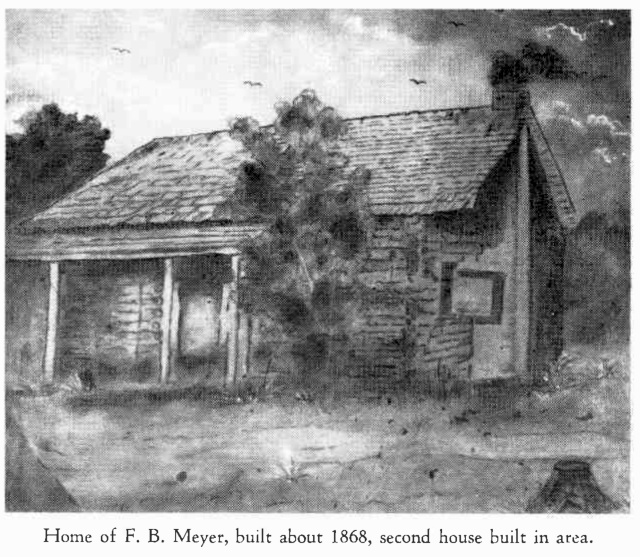 Obtaining the staple foods was quite a problem. Tampa was about 32 miles distant and there was no way of transportation except riding through the forest. Cedar Keys was about 75 miles by boat. The nearest store was a log house on the bay, 18 or 20 miles by water–the spot where Clearwater now stands. Obtaining meat was no great problem as the woods abounded in game–deer, turkey, squirrel, and quail, which afforded the young men a lot of sport. My mother had a pet deer. The soil was very productive. News of this growing settlement began to spread and soon others were added to this little village. As the sponge industry expanded in Key West, the spongers went out in quest of other fields and discovered that off the coast of Anclote and Rock Island there were beds teeming with sponge of different varieties. A large fleet of vessels began to appear, bringing men from the British West Indies and Key West. Over 90 per cent of the men were of English extraction and as they made frequent visits ashore they soon became acquainted with women of different backgrounds. In the course of time, many unions took place between these hardy men of the sea and gentle ladies of southern plantations. This combination of sailors and farmers produced the strain of citizenry that settled this part of the country. Let us name some of these men: William Watkins married Alice Meyer and the union brought six children, some of which married farther up the coast at Hudson and some who married and settled at Ozona; Joseph Thompson married Sallie Meyer and to this union were born two sons and a daughter. Of these boys, Grady Thompson, is one of among the best boat builders in this vicinity. Hiram F. Pent, from Key West, the writer’s father, Josh Boyer, who later settled at Tarpon, Sam Baker, Ben Baker, Tom Pinder, John Pinder, and John Sawyer, also George Roberts, who settled at Elfers, then known as the Sapling Woods, all played a part in the settlement. In order to get a knowledge of the city, it is necessary to know about these men, as they all later played important roles in the industrial progress of Tarpon. As “all roads lead to Rome,” so all roads led to Tarpon Springs. In 1878, Captain Samuel Hope came to Anclote from Brooksville, and as he had a large family of boys and girls, who were fond of music, and a wife who played the piano, their home became quite a social center. Captain Hope, who was an ex-Confederate officer, was wounded on the battlefield during the War between the States. Mrs. Sarah Meyer, my grandmother, left her piano on the plantation as there were no roads in her time–or suitable means of transportation. Later, Allan Hill came with his two daughters, so with the young people of the two Meyers families, life became more interesting for them. 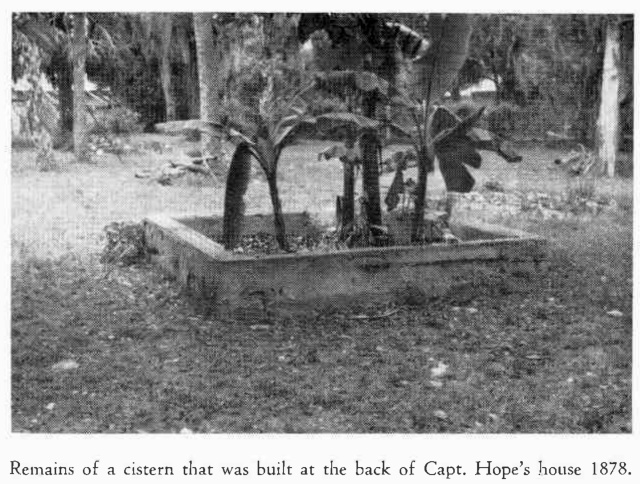 In 1877, James Craver came from Illinois and settled at Yellow Bluff, now Palm Harbor. On January 29, 1878, John M. Craver, his brother, came from Illinois and settled at Anclote. Mr. Craver was a great asset to this growing community. He opened up a grocery store and established a Post Office in the same building. He also carried a stock of basic medicines–quinine, calomel, pills, salts and such remedies as pioneers generally needed. During the absence of a physician, he would minister to the sick if called upon. Mr. Craver also became Sunday School Superintendent. The historic Spanish Well was a familiar spot to the settlers of Anclote. Supposed to have been dug by the Spaniards, it was about one half mile west of the village near the mouth of the river. It was used for many years by spongers and other boatmen. Many pioneers have drunk water from it numberless times. It has long since disappeared from view, covered by erosion, high tides and mangrove bushes. How interesting it would be to have a marker on that historical spot, to commemorate the activities of the Spaniards and sailors of bygone days. Here shall be mentioned one of two brothers who have lain in the old Anclote cemetery for 87 years or more. Franklin B. Meyer, a veteran of two wars, first ran away from college at the age of 17 and joined the United States Army. At that time, the United States was at war with Mexico concerning the boundary line between the two countries. Mexico claimed the Nueces River as the boundary; and the United States claimed the Rio Grande as the boundary. The U. S., of course, won. It was to this struggle that young Frank Meyer volunteered his services. When the War between the States was precipitated, Frank was married and owned a plantation of some 250 or 300 acres, with slaves to cultivate it. Naturally, he joined the Confederate Army to fight for what he considered his rights. Many brave men have given their services, with good intentions, to a wrong cause. After the war, he died of yellow fever, which was prevalent at Cedar Keys. Harry Ferguson, was a young school teacher from Charleston, South Carolina. He came to Brooksville–and since there was no means of further transportation, walked from Brooksville to Anclote–a distance of nearly 50 miles, arriving in the village probably in the year 1878. Like many other young men who came to Anclote, he found a wife. Mr. Ferguson married Miss Mamie Reeves Meyer. As there was not much a young married man could do in this undeveloped country, he started a school and taught the children of Anclote, a village which had begun to expand. Incidentally, Mr. Ferguson had settled on the south side of the river. As time went by, more people began to immigrate toward the south: Seaside, Clearwater and other places were settled along the coast. Since no bridge crossed the Anclote River, travelers forded the river at Seven Springs, Mr. Ferguson conceived the idea of a ferry. He had a large flat-bottom barge built, that could carry a team of oxen, which were used a great deal at that time. Horses and wagons, buggies and people were ferried over also. As there were no gasoline engines, or even steam engines to be had at that time, young Ferguson pushed this barge across the river with a long cypress pole–the water was not over five or six feet at low tide. One day he boated a team of oxen and before getting away from shore, they became unruly and jumped overboard. After some difficulty, and a few bruises, they were retrieved. The ferry crossed the river between the Watkins home (Whitehurst) on the north and Casa Mia on the south near Mrs. Harry Lewis’ home. Years later this place was known as Ferry Point. It is too bad that some of these traditional sites were not preserved, at least in name, as treasured memories of the past. On January 5, 1875, H. F. Pent and Lucy L. Meyer were united in marriage at the Meyer homestead by Reverend James Kilgore, a Methodist minister. Reverend Kilgore came from a place, since named Ozona, 20 miles to the south. William Hart came with the Reverend by horseback. They crossed the river in a small boat, wading and swimming the horses behind them. The horses were tethered to trees and some time during the night Mr. Hart’s horse became entangled in his halter or bridle and the next morning was found choked to death. To this union were born four children, one son and three daughters, Sarah Amelia, Robert Franklin, Cora Estelle, and Clara Elma. Two are alive at this date, December 13, 1963 – Robert Pent and Mrs. Cora Davis, both of Tarpon Springs. Soon after this marriage, Mr. Pent homesteaded a tract of land on the bank of the Anclote River and built a log house on the spot where the Linger Longer auto camp now stands near the Bradley home. That is where this writer discovered America, June 25, 1878. Many and cherished are the memories that linger around the old homestead and the river where we learned to fish and swim. 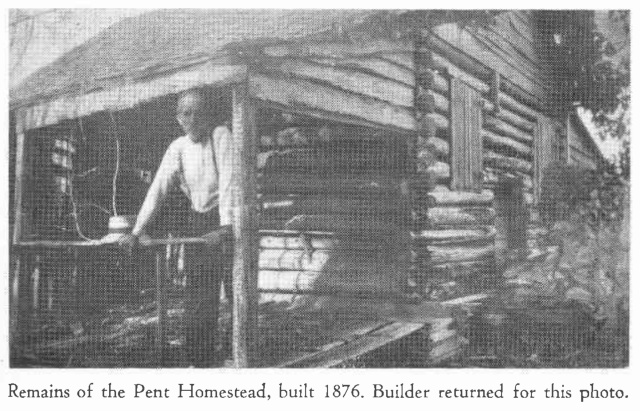 As Anclote continued to grow, there arose a need for a community building. H. F. Pent constructed a small wood building which became the schoolhouse, church, place for entertainment, Christmas exercises, in fact, the place for all public gatherings. My sister, Sadie, and I walked two miles or more, regardless of the weather, to attend school. There is quite a difference between that primitive little house and Elizabeth Hall at Stetson University, where I attended many years later. The Crosby family, from Missouri, moved into Anclote and Miss Cora Crosby, a maiden lady, became my first school teacher. Well do I remember when she tied me in my benchseat for misbehaving. That symbol of education, religion and other efforts toward civilian life has long since disappeared and nothing remains but scrub oaks, where children played and people went to church. Strange to say, nothing has been built on or near that spot, which is about 50 feet north of the Anclote road and 50 yards east of the Baptist Church road. I wish to pay tribute to the memory of William Watkins, who sometimes sailed or rowed his boat to Tarpon, met a minister from somewhere, brought him to Anclote, contributed five dollars, and gave him a safe return. Now five dollars in that day and time was quite an addition to the collection. It certainly loomed up beside the dime or quarter people dropped in as the basket passed by. Needless to say, this hard-working man always had food on his table, possibly just a little more or better than some of the other people had. Anclote continued to grow. Mr. Morrish, an Englishman, moved in with his family and became the grocer and postmaster, Mr. Craver having moved out. On the south side of the river, a very talented family by the name of Murphy settled. She was an accomplished musician and he was a composer. Mr. Murphy was born in the old country, but he composed Salute the Flag, a fitting tribute to America. Arthur Farquar, an Englishman, also settled on the south side and became one of a company which erected and operated a large sawmill on the spot where the Victor chemical plant now stands. This mill was quite an asset to Anclote as it employed some of the citizens and brought in other men who spent money there. One night, to the dismay of all, the mill burned to the ground, almost a total loss. It has been said that a Negro by the name of Jason Toombs, an employee, did the job. Before leaving Anclote, we must mention the lighthouse, a steel structure 105 feet high with a solid concrete base. This was built around 1887 about five miles off shore on Anclote Key and was quite an aid to navigation, especially coastwise boats. Anclote light was a flash light and listed as such on the coastal charts, and remained as one for many years. Those intermittent flashes distinguished it from Egmont light or others which burned steadily. Different men kept this light: Ed Hope, Dr. Baggett, Angus and Uncle Robert Meyer, who kept it for 30 years and retired on pension. You could stand on the ground and see the sun set, then run up the stairs and see it set again. Anclote light is still a flash light but it doesn’t operate by keepers who had to live on the island; rather it is operated by the Coast Guard on a different system. Between 1868 and 1875, while Anclote was being settled, Tarpon remained an unsettled forest, and along paved streets where automobiles now park and run, wild game, such as deer, turkey, bobcats and other animals, roamed at will. My uncles, who were hunters, and have long since passed on, could attest to these facts, if they were here today. 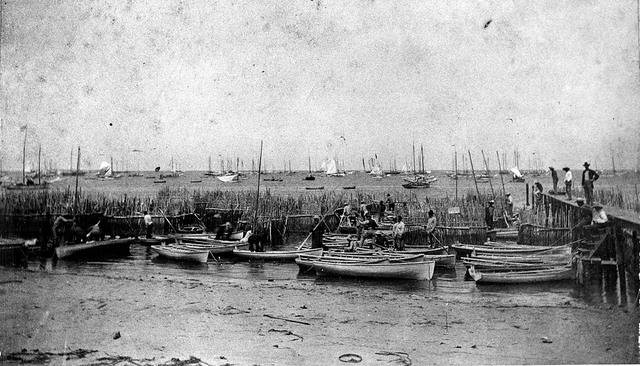 Chapter 2 Tarpon SpringsIn the year 1877, J. C. Boyer came from Key West to the mouth of the Anclote River in a sailing vessel. From there, he ascended the river in a small boat to Spring Bayou. The only family living in the immediate vicinity was A. W. Ormond and his daughter, Mary, who had come to Florida with him in 1876. W. B. Thompson lived about three miles south by his orange grove. Mr. Thompson was the grandfather of Mrs. Harry Jukets of East Tarpon Avenue. Another family by the name of Clark moved to the south end of Whitcomb Bayou. These three families comprised the population of Tarpon Springs. Later, Mr. Goethe settled on what is now the Ed Beckett grove, about two miles northeast of the old bridge. The city was probably named by Mr. Boyer, because of the number of Tarpon sporting and jumping in the waters of Spring Bayou. We have seen many silver kings in the bayou since that time and some have been hooked by fishermen, but they have long since disappeared from the spring, probably because of the many motorboats plying the river. 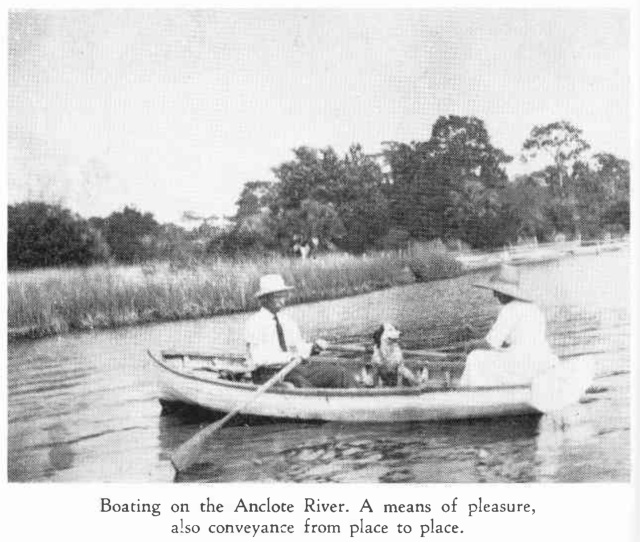 People along the Anclote River soon became acquainted with these far-flung neighbors and a mutual feeling of pioneer fellowship sprang up between them. Visiting facilities were very primitive; walking, riding horseback, even the lowly ox-cart were means of conveyance. And, last but not least, the rowboat was much used. We visited the Boyers at Tarpon and on one occasion, my father rowed his skiff up the river to the first bridge to visit Captain Kendall, who had moved there from the north. In the mean time, Mr. Boyer had married Mary Ormond and settled down. His house was just south of where the Publix now stands. Later, he operated a livery stable on the lot owned by the Publix today. A few years after that, Boyer’s mother and brother, John, came from the Bahamas West Indies and built a house near the southwest corner of today’s Pinellas Avenue and Lime Street. This home remained there for 82 years and was recently removed to give place to other buildings. 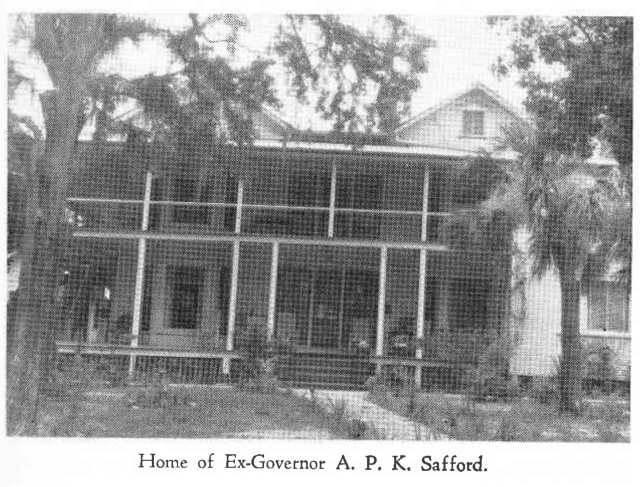 During this time, Anson P. K. Safford went to Arizona from an eastern state and became its first territorial governor. There is a place in Arizona named Safford at this time. We now approach a new dimension for Tarpon Springs. In 1875 George Inness, a famous American artist, discovered the scenic beauties of Tarpon which he and his son, George, Junior, later depicted in their paintings. When the tide of immigration began to flow south, in 1880, Hamilton Disston, of Philadelphia, purchased 4,000,000 acres of Florida land on the central west coast. He paid Governor W. D. Bloxham twenty-five cents per acre. Governor Safford left Arizona and came to Tarpon as land agent for the Hamilton Disston and Jacob Disston Syndicate. Tarpon was then founded in 1882 by A. P. K. Safford. The town site was laid out by Major W. J. Marks and surveyed by John C. Jones. Hitherto, the settlers in and around Tarpon were from the south–people of culture from southern plantations. The growing pains of Reconstruction Days had not entirely disappeared. A large per cent of those around Elfers, Anclote and Tarpon were of English descent from the Bahamas West Indies and cared little or nothing about the recent conflict between the states. People from the North were coming into the Deep South in greater numbers, to live and build a town among people, who, a few years ago, were their bitter enemies. People with varying backgrounds, ideologies and idiosyncrasies were to unite their efforts in absorbing the complexities and hardships of building a town. Everyone went to work with a will. In 1884, a post office was established with Ed Blum as the first postmaster. This post office was between Anthony Proesto’s real estate office and the Sylvania Motel on West Tarpon Avenue. In 1887, Tarpon was incorporated with a population of 52 residents and elected Mr. DeGolier as the first mayor and Mr. Platt the town marshal. Mr. DeGolier lived on Spring Boulevard one half block west of the Safford residence. Governor Safford had married a beautiful, talented young Mexican woman while serving in Arizona. She, with his two daughters, Marguarite and Gladys, and his adopted son, Leandro, came to Tarpon when the Safford home was on Spring Boulevard, the same location where the late George Clemson’s home now stands. The home is now owned by A. Ferris Hollis, who moved the old Safford home to the rear. Let us look for a while at the first business section of Tarpon. Can you imagine stores, millinery shops, post office, and oyster house on West Tarpon Avenue? Mr. Blum, a Russian-Jew, came to the United States–and in quest of further adventure, came to Tarpon. We wondered what there was in this unsettled wilderness to attract a businessman. But the history of the Jew is thus; on the frontiers of commerce and industry you will find him in the forefront doing business. He seldom, if ever, goes into bankruptcy and with his Jacob-like sagacity and ingenuity, does a good business and nine times out of ten, he succeeds. The Blum family made a great contribution to the commercial and social life of this place. The elder Mr. Blum erected a two-story building. The lower part was stocked with general merchandise while his family lived upstairs. Dr. Blum, who built his home across the bayou, was the first dentist. The young ladies and young men contributed their part to the social life. A few yards to the west of the store was a millinery shop, located where the Sylvania Motel now stands. This shop was operated by Mrs. George, a Jewish woman, who had one son and two daughters. The eldest daughter married Mr. Platt, the town marshal. The Post Office was between Mrs. George’s store and the grocery store. Right across the street was Tarpon’s first bank. Leandro Safford was the cashier. Upstairs was where Tarpon’s first brass band assembled. On the corner, where the Gondolier Motel is now situated, G. E. Noblit owned and operated a cold drink and confectionary store. H. F. Pent had an oyster house at the same corner. Mr. Blum, the merchant, had a high dock built on a level with the street with a large warehouse for storing merchandise. There was no railroad here at that time and all the merchandise, as well as passengers, came to Cedar Keys from Fernandina, Fla. by rail. They were then transferred to a steamboat by the name of Governor Safford and brought to the mouth of Anclote River where the stock was stored on a pier. A smaller and lighter draft steamer, the Mary Disston, transferred the goods to Tarpon Springs. Horse-drawn drays could drive out on the dock and haul Mr. Blum’s mixed stock of commodities to the store. 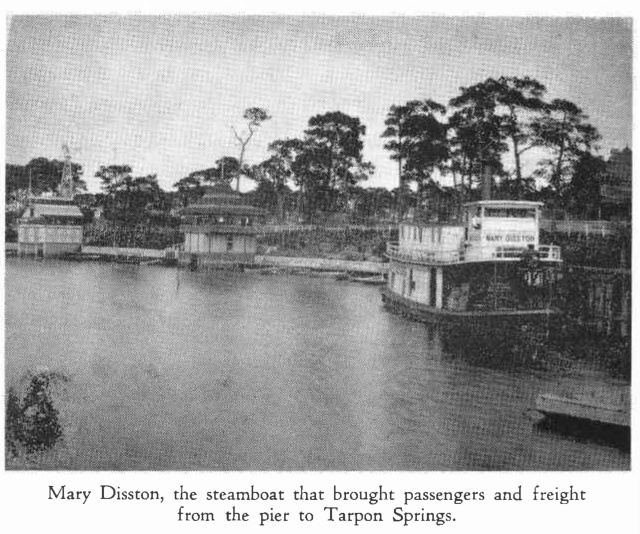 Later on, some merchandise began to come in from Tampa, which was only 29 miles via Sulphur Springs and Keystone Park. The roads were sandy and travelers had to wind their way around lakes, ponds and across creeks. Several methods of transportation were resorted to, such as ox-carts, horse and wagon, horseback, and sometimes pedestrians were brave enough to try it afoot. In the meantime a few scattered settlers had taken up land between Tarpon and Tampa. Mobley, Strickland, Patterson, Moody and Swain were the names of some. Later Mr. Little and C. D. Webster came from Pennsylvania. Mr. Little settled in the community and named it Keystone Park. Mr. Webster purchased land in Tarpon and established the “Old Reliable Drug Store,” which has served Tarpon for about 80 years and is still doing business although ownership has changed. Citizens of Tarpon remember Webster Little who owned and operated this business for many years. Little was a nephew of C. D. Webster. Mrs. Little, the widow of Webster Little, now resides at her home on the corner of Ring Avenue and Cypress Street. Chapter 3 Health ResortOn the east shore of Spring Bayou, just below tide water, a mineral spring was discovered. It is not clear what the analysis of this spring was, but those who drank the water seemed to derive great benefits from it. The spring was curbed and housed with a pagoda and became a favorite loitering place for invalids and old veterans, who spent the time reminiscing, telling what they knew–and possible some things they didn’t know. At any rate, Tarpon began to acquire a reputation as a health resort; probably the change of climate and balmy air had much to do with the healing of weak lungs and overworked nerves of some who came from cold climates. Since the influx of people began to increase and housing facilities were not adequate, it was necessary to build hotels. Accordingly, the Tarpon Hotel and the Tropical Hotel were built about 1883. The Tarpon occupied a large space covering the ground where Dr. Belcher’s office and the Florida Power office as well as other buildings now stand. This was a large, spacious, three-story building with a veranda on three sides. 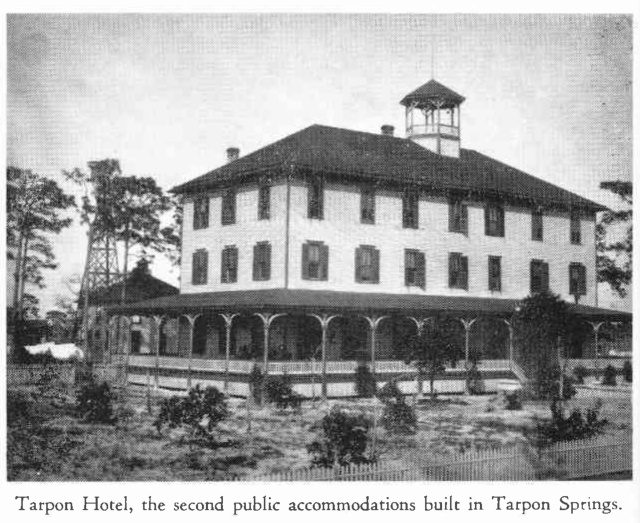 The hotel was seasonal in its operation, opening in the fall and closing in the spring. The proprietor brought all of his help from the north, with a few exceptions. The Tropical Hotel was built on the southwest corner of Tarpon and Pinellas Avenue, where the Sunoco filling station is operated. This was built a short-time before the other hotel, probably 1881 or 1882. The Tropical was a two-story building with a veranda on north and east sides, up and down stairs. They were open from January to December and seemed to be more of a community building, as the citizens met there for many occasions. A very tragic affair happened late one afternoon. Major Marks and Mr. Connolly got into an argument in the Tropical Hotel; hot words were exchanged and Connolly ran to get his revolver. Marks made his escape through the door, or window, before Connolly could return. When he did, he ran out on the front porch, looking up and down the street for Marks. It was twilight and visibility was poor. A man by the name of Cork was coming up the street and Connolly, thinking he was Marks, fired, killing him instantly. 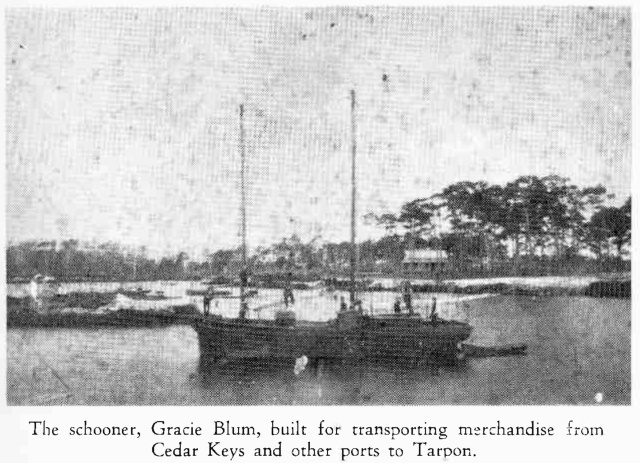 My father was present at the inquest. Mr. Connolly, after spending some time in jail, was freed by the courts and given his liberty. Connolly bitterly repented this rash act and later became a minister of the Gospel. This is a very strange coincidence you say. Yes, indeed, but “with God all things are possible.” Stranger still, a very grim joke grew out of this affair. The saying became current that Tarpon was so healthful, someone had to be killed in order to start a cemetery. Getting back to West Tarpon Avenue, our wide-awake, enterprising merchant, Mr. Blum, conceived the idea of getting his commodities from Cedar Key and other places by his own means of transportation. Accordingly, he had a fourteen-ton schooner built and named her after his granddaughter, Gracie Blum. This boat was built on Salt Lake, east of Tarpon, and my father helped do the job. The next problem was launching and getting her under the bridge that had been built across the river, northeast of town. The hull was launched without masts, or any other extra weight, was taken out of the lake and down the river to the bridge. At a suitable tide, it went under the bridge without any trouble. After the masts were stepped and the rigging put on, it was not long before she was ready for sea. My father, Captain Hiram F. Pent, was aboard on her first trip to Cedar Key. In the meantime, East Tarpon Avenue began to build. J. M. Vinson came from Tallahassee about 1884 and immediately established a business of general merchandise on the north side of Tarpon Avenue. G. W. Fernald later built a store and dwelling house near the same location. Mr. Webber also established a grocery business at Tarpon and Safford Avenue. East Tarpon Avenue really began to boom. Mr. Bremner established the first bakery on the south side. Mr. Dickerson, an Englishman, opened a taxidermy business, about where the Peoples Hardware now stands. The woods and swamps abounded in wild animals and birds, so it was not much of a problem to procure specimens for stuffing and mounting. Mr. Dickerson’s family lived at the same place. Jobs for boys, and even men, were scarce, so trapping, shooting and obtaining birds and animals in various ways afforded means of earning some much needed cash. Although there were no game laws at that time, many rare specimens were hard to get and required much patience and skill. I remember hunting alligators one night with Mr. Dickerson the taxidermist on Sawgrass Lake, just north of town. We were in a small canvas boat and used a bull’s-eye lantern to shine their eyes. We shot one small alligator. If we had wounded a large one, there probably would have been plenty of action. 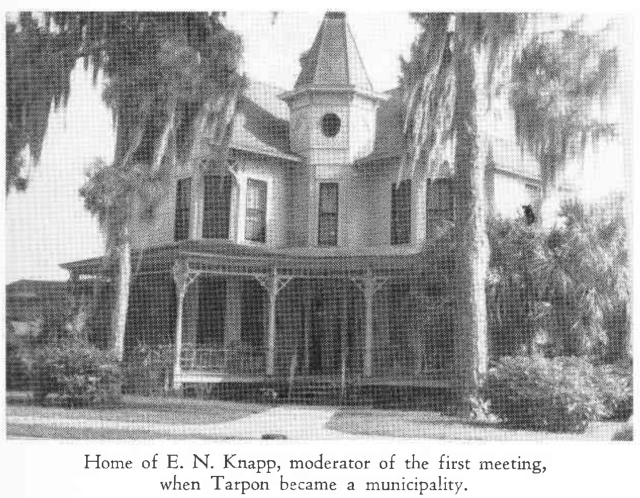 There was a barber shop about where the Greek fruit store now stands and Mr. Bremner’s bakery stood where the Burgess Hardware is located today. To the west was the hardware store owned and operated by Horace Webster and Osmond Knowles. In the same building was the drug store operated by George McAroy and his son. Just a few yards farther west was the Fowler jewelry store and home. A great fire destroyed everything from the McAroy Drug Store to Safford Avenue. Several buildings on the north side were burned including Vinson’s and Fernald’s stores. Recently an old document was found in the City Clerk’s office, which had been there perhaps over half a century. This article recorded the meeting of the City Fathers in which Tarpon became a municipality. It showed the election of officers, appointment of town clerk, etc. I personally knew all of the men mentioned, the aldermen, mayor, clerk and marshal. 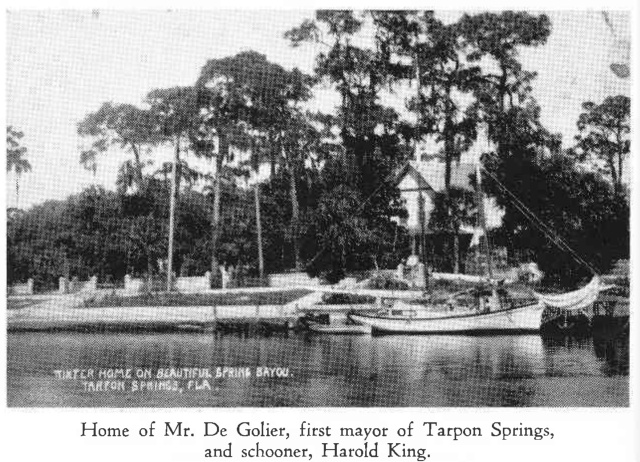 There is one thing that greatly confuses me, the date. I was born June 25, 1878 and we moved into town from the old homestead in 1885. A. H. Platt, the first town marshal, was living on Boyer Street just across from our new home. He had been marshal for some time. I remember E. N. Knapp, who moderated that first meeting. His home, which is 80 years old, stands on the south side of Spring Bayou. It is one of the best looking wood structures ever put up in Tarpon and is in a good state of repair. He also had a boathouse on the bayou, but that has long since disappeared, as the others did. While speaking of the bayou, we are reminded that the cement walk has been rebuilt, the dock has been enlarged, remodeled and beautified with shrubbery, which lends greater beauty to this scenic part of the city. Merrick Whitcomb, who was appointed secretary for this first meeting, was later elected City Clerk by acclamation. He later succeeded Ed Blum as postmaster. C. D. Webster, one of the aldermen, owned and operated the Old Reliable Drug Store. It has passed into other hands, but still retains its old name. Mr. Scott, an alderman, was quite a fisherman. He had the first rod and reel I ever saw, and certainly was an adept at handling it. I watched him one afternoon, fishing at an oyster bar, near the old Meyer home, hauling in redfish, one after another. Mr. DeGolier, the first mayor, had a son named Miles, whom we have mentioned previously. I was with him once in a rather exciting sailboat race. Malcolm Hill, at the risk of his life, went to the rescue of Capt. Sam Hope on the battlefield in 1863 and brought him to safety. Mr. Hill lived for a number of years at Port Richey. He had two daughters, Carrie and Alice and three sons, Tom John and Clarence. Miss Carrie was a practical nurse, Clarence was marshal of Tarpon Springs, and Malcolm, a grandson, practiced law at the same place. Mr. Hill moved to Tarpon where he spent the remainder of a long life. Chapter 4 AnimalsAs has already been stated, the woods abounded in wild game. Not only deer and turkeys, but coons, foxes, opossums, otters, skunks, bob-cats, panthers and finally, wolves. These wily, carnivorous animals would howl at night while mother was alone with us kids on the old homestead. Father had to be away from home much of the time earning something to keep the “wolf from the door.” As for the panther, these stealthy felines are very strong and ferocious. A dog, or even two, are no match for one; I have been told that when a dog strikes a panther’s trail, they begin to whine; there is nothing pleasant ahead. The scream of a panther is a bloodcurdling sound; it is very much like the cry of a woman in distress, only louder. It would be a good signal gun to start a foot race. These animals are fast becoming extinct in the open areas. The alligator was often seen and by far the most numerous of the dangerous animals. I have seen three or more at one time at different places in the river. They ranged from five to ten feet in length. Though they were numerous, no boy or girl was ever caught by one in this vicinity. When we went in swimming, we kept a sharp lookout for them. I remember one scaly old saurian who took his siesta daily on the river bank just east of the Victor chemical plant. Most people think that hitch-hiking came with the automobile, but not so, one alligator played that stunt 75 years ago. My father was towing a raft of lumber behind his boat up the river when an alligator slithered up on the planks and hitched a ride. Dad didn’t have his double-barreled shotgun or it might have been another story. Fish were plentiful in those days; schools of mullet by the thousands, with their back fins out of the water, were so thick, there was hardly room to swim! My youngest uncle, Wyatt Meyer, threw his large castnet into a school and covered not only mullet, but a seven-foot shark as well. Being thus disturbed, the whole outfit started off shore, carrying my uncle with them. His older brother, Gus, came to the rescue and saved him and his net. ALLIGATORS We have mentioned these amphibian reptiles previously, but this one was exceptionally large. Stafford Youngblood, one of the boys, located this ’gator under the bridge on the east side of Whitcomb Bayou. This bridge was made of wood, but is a concrete bridge now. After dark a crowd of men and boys went to the bridge with a lantern and a strong rope. In a few minutes we had one of the long boards torn up and a noose slipped around the ’gator’s neck. With the combined strength of men and boys, we hauled this immense saurian out on dry land. He was securely tied to a pine tree and left for further disposal. Citizens, hearing of this capture, began to come in crowds to see this ’gator. Mr. Richey, the man after whom Port Richey was named, was mayor of Tarpon at this time and sensed the danger of people crowding around so he shot him. An alligator’s best weapon on land is his tail, and with one powerful blow can turn a hog, man, or even cow topsy-turvy, sometimes breaking their legs. This alligator measured 11 feet and 11 inches long. Once, while hunting around a small pond, I walked out on a knoll. After scanning the pond for a few minutes, I glanced down, and directly under my feet was a tip end of an alligator’s nose. I was content to give it a poke with the gun barrel, and walk away. I will never know how many feet of mama-gator was back of that nose. I came back another day and caught a little one and, in turn was caught by the thumb. One morning my father was awakened by the squealing of his hog, Old Darby. Jumping out of bed, he grabbed his shotgun and took off through the woods. Arriving at the scene, Old Darby was disappearing beneath the water in the jaws of an alligator. Once an alligator had her nest near where the Yacht Club is located. We boys thought it great sport to pelt her with brickbats or rocks, and make her bellow. An alligator usually barrows under the edge of a pond, or hole, to make her home. Sometimes they are 10 or more, feet deep, and room enough to turn around as they go in, and come out head first. However, we never explored one to find out. While in the waters of the Suwannee River, a man was caught by the arm in the jaws of an alligator. His friend on the bank was afraid to shoot, as he might hit the man instead of the ’gator. He stood and looked on helplessly, while the man was dragged to his doom, calling for help. At another time, some boys were gathered at their favorite swimming place on the Suwannee. One outran the others and dived in first; there was a swirl in the water and he disappeared, never to rise again. The beautiful, and historical Suwannee probably has recorded numerous tragedies that have occurred across the years. Chapter 5 Spring Bayou, Music and Boat RacingSince Tarpon Springs has so many inland waterways, it has long been called “the Venice of the South.” Perhaps the one most often sought and least understood is the scenic and mysterious Spring Bayou. The fountain throws its silvery spray just on the edge of the spring. Hundreds of feet of line has been let down into this fathomless abyss without reaching the bottom. Only one deep-sea diver has explored the depths of this bottomless hole. George Gause descended and found many old relics of bygone days–ropes, fish lines and anchors that had been lost from time to time along its rocky ledges–but no bottom. 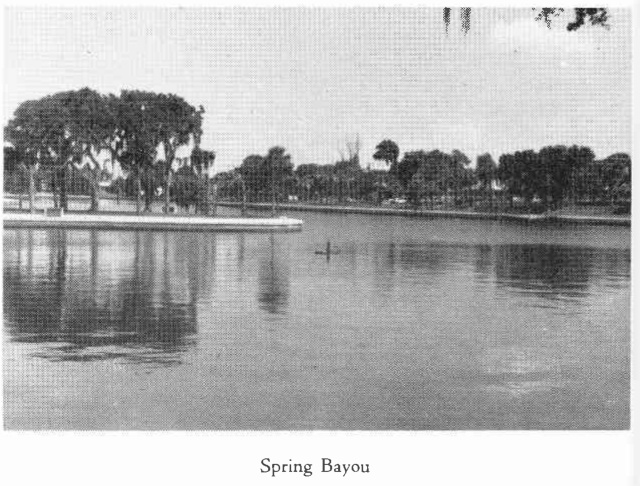 The fact that has long been established is that this spring was an outlet of a subterranean passage between Lake Tarpon and Spring Bayou. When Lake Tarpon becomes too full, the spring breaks forth and boils, then the water in the lake subsides. Seventy-five years ago, when this writer was a boy, there were no barnacles in Lake Tarpon; but now, the blue crab can be found there and submerged wood gathers barnacles. A certain amount of salt water has filtered through this passage; then somewhere between the lake and the bayou, sulphur is injected into the water. At times you can smell the fumes when the spring boils. When there were many boats moored in the bayou, their white hulls were badly tarnished by the sulphuric content of the water. When Tarpon was a small town, the bayou was much used for bathing. Every afternoon, with few exceptions, there were men, boys and sometimes women and girls bathing in the waters–diving, playing tag and ducking one another. Sometimes a mud fight would occur. There were four large boathouses along the north and east sides of the bayou. They afforded good places for changing clothes. 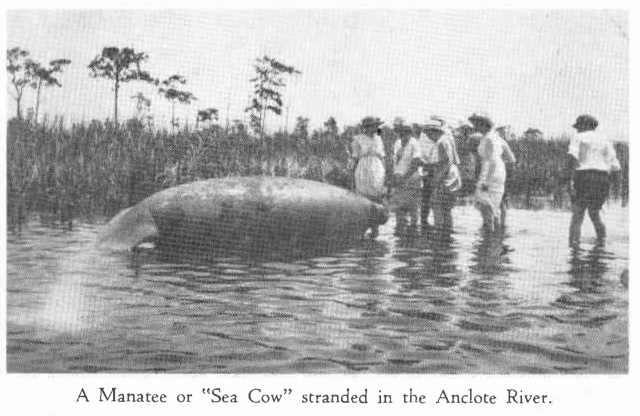 These boat houses had an upper story, where they had band practice and sometimes a dance. We boys would jump out of the second story and if the tide was low, usually hit bottom. When a boy attempted to go out and dress ahead of the crowd, he was often plastered with wet sand before he got out of range. This usually kept up for a while, sometimes tempers flaring. Angler’s Point, just across from the dock, was a good place to fish. Many of the youth in olden days went to this favorite spot with cane poles and bait, usually crabs, and were rewarded with Sheephead or Drum. Sixty years ago, and earlier, there were hundreds of small fish called chubs, which were excellent bait for Trout or Redfish. They were usually along the shore in shallow places and sheltering nooks. They always seemed hungry and could be easily caught on a small hook or a hook made from a pin. We boys made most of our money selling those minnows to sportsmen like Jacob Disston and others, for a penny each–and sometimes two cents each. In later years we have tried to catch those chubs, but they have almost disappeared. Crabs were plentiful along the shoreline and it was no hard task to spear them. They were good bait, especially for Snapper, Drum, or Sheephead. BOAT RACING We now come to a part of Tarpon’s life which was very enjoyable, but a part in which everyone could not participate. Boat racing once required a daring spirit in order to enjoy the sport and make a go of it. Yachts of today have a heavy lead or iron keel which takes the place of a center board. It also keeps them from turning over under a large spread of canvas. Yachts of that day carried heavy ballast, pig iron and bags of sand and required a crew that could shift it at a moment’s notice. Most of this ballast had rope handles, so when a fellow climbed up to windward, he carried his pig iron or bag of sand with him. Many times I have leaned over the windward side and seen the centerboard. It was a beautiful sight to see this fleet of boats in a heavy breeze with their white hulls and white sails, listing until you could see the copper paint on their bottoms. These were small boats, with few exceptions. The Lucy, owned by Jake Disston, was in the larger class. She was a beautiful cat rig, one large sail, with a high bow and graceful lines. The Boston Bean Pot, owned and sailed by Commodore Finney, merited her name. She was almost as wide as she was long and carried an immense spread of canvas. There were three mosquito boats, the Dennis, owned by Jake Disston, the Floralee, owned by Dr. Reed,–and the Bertie, owned by Mr. Flemming, which was the prettiest of the three. G. E. Noblit bought a sharpie from the Blum boys, had her remodeled and named the Lucy B. This was his race boat for a while. Bill Cannon and Captain Kendall, both old vets, were good boat-builders. Mr. Noblit had another boat of a more modern style, built and named her the Mermaid. We are not certain as to who built this boat. I was a favorite ballast-shifter for Mr. Noblit as we sailed with him in both of these boats. He was a very enthusiastic racing fan and would sometimes be in high glee when his boat was squared off before the wind with all sails taught. Richard Clemson owned a beautiful boat named the Topsy. She was a cat rig, a good sea boat and plenty fast. Bill Roberts, grandfather of Mickey Roberts, won a race in this boat. 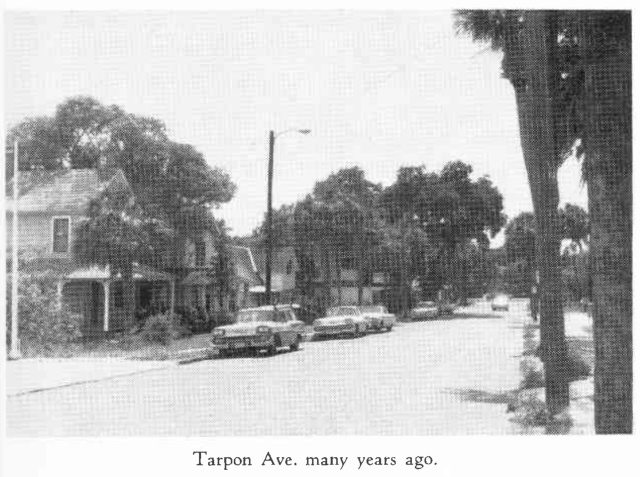 There were numerous boats at Tarpon Springs of which I will not speak at this time, except one, I cannot omit, the Fleet Wig. She was owned, I believe, by a Mr. Levis and she was different from all the other boats–deep and cranky. When the sail was down, the boom had to be in the center. If you tried to go around her mast you had to be quick or she would turn over. She was nothing but a racing boat. No land lubber could handle her. Such daring spirits as Miles Degolia, Alfred Allen, Walter Topliff and a few others were the boys for that boat. One afternoon as we rounded the stake in a race and started on the home run, before the wind, her big mainsail was to starboard and a spinnaker to port. We crowded aft to keep her bow from going under. Her deck was awash, but Miles did a good job and we crossed the line without a mishap. That was 69 years ago, but it thrills me even now to write about it. The Fleet Wing was the only boat painted black. No boat could out-point her on the wind. Sometimes they would go outside and sail around Anclote Keys. There were two large sloops in the fleet, the Vinessa, owned by J. M. Vinson, and the Tantalus, owned by Josh Boyer. I remember seeing a third of her bottom paint once, while she was winning a race. There was one individual who just could not stand to be beat. If he got too far in the rear, he would capsize or fill his boat half full of water. That of course, would throw him out of the race. I was with him on such an occasion. Once I was in the Dennis with Jake Disston, when her mast broke and went over the starboard side. We got a soaking when Rube Jones turned Charlie Barstow’s Skipjack over. The Mrs. S. capsized on one cold winter day, with Alfred Allen, Walter Topliff and myself. We were not in a race. Occasionally, we gave Clearwater a chance to try their luck in racing ability, but they had only one qualified boat, the Winnie Davis, so we usually brought back the trophy. Clearwater had a beautiful race course in the open bay, but they were lacking in racing fans, money and boats. Saint Petersburg was a small village at that time. I do not know what became of our fleet of beautiful boats. The Disstons moved away, as did many of the others. The boats were probably sold and taken to other towns. There was only one motorboat here for many years. The Pastime, a naphtha launch owned by Leandro Safford. Tarpon early exhibited a spirit of sportsmanship in many phases–swimming, diving, boat-rowing, and even tub-racing was practiced. Baseball was not the least among these activities. We had some good players and occasionally crossed bats with neighboring villages and towns, which came into being as time went on. San Antonio, Sutherland, Ozona, and Clearwater were places which vied with Tarpon for the scores. We put Clearwater in the shade when it came to boat racing, but in baseball, Clearwater carried off the laurels. In later years Clearwater stood high in football too. MUSIC In Tarpon’s earliest days, talented people filtered into the town from various places. Musicians, vocalists and performers of different kinds soon began to find their place in concerts and entertainment. Adequate places for concerts were not available, but substitutes, especially the schoolhouse, were used. Professor Smeltz, a German, became the first band leader. Second story of the bank building, a wooden structure, was the band room. The bank was on West Tarpon Avenue a few yards east of the present location of the Gondolier Motel. Professor Smeltz discontinued leading the band and later it was reorganized under the leadership of Leandro Safford. The band continued for a while then ceased to function. About 1897, a barber by the name of Frank Merry, from Michigan, organized a band, with two of the former band boys, Louis Styles and Frank Fernald. We had 12 or 13 pieces. Tarpon Avenue was paved with clay so we would march and play in our uniforms, consisting of a black coat, white duck trousers with a black stripe. Belleair had a fine race track for bicycles. Professionals from other states and even abroad would match their speed and endurance on this track. We were invited to play for these races and were paid $25. for our service–some remuneration for 12 men! But we enjoyed it immensely. The trick rider did his stunts to the rhythm of Silver Lake Waltz. I was in the vicinity of that beautiful race track a few years ago and not a semblance of it remains. 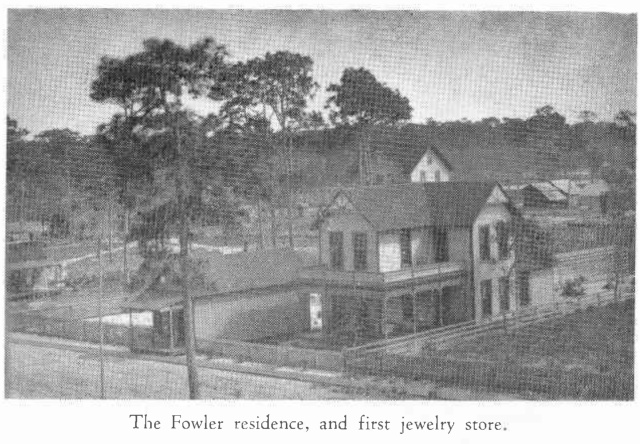 Mr. Casting brought a recorder into the band room ones, secured some of our pieces and reproduced them, while we listened in. The band continued for a while, then some began to drop out or go away and finally we disbanded, leaving Louis Styles custodian of the music. Tarpon has been favored with many and better bands since that day; even the famous Kryl Band resided here for quite a while and made its contribution of musical culture in concerts and performances. Our high school bands claim their share of recognition in Gasparilla parades and celebrations of different kinds. Chapter 6 Schools and ChurchesTarpon’s advance in education, from the old-time recitation bench, to higher curriculum, was somewhat slow for several years. The first school teacher of which I have any knowledge in Tarpon was Miss Dyer. She had a small cottage across the bayou, northwest of Dr. Blum’s residence. Why this brave little woman chose a home in the woods, we do not know. She has, no doubt, rowed across in a skiff. Just here, we are happy to say, Tarpon has not been noted for crime against women, even since it reached city proportions. The first school that I attended was on North Pinellas Avenue. The old two-story wood building stood just where the now abandoned elementary stands. Many are the memories of those by-gone years–some pleasant, some otherwise. Once in 1889 or 1890 a staff of archeologists from the Smithsonian Institute in Washington, D.C., under the leadership of Dr. Cushing, excavated an Indian mound, just north of the school. They worked on this mound carefully, for quite a while but time and decay had left their mark on these skulls, and bones so they were not able to salvage many good specimens. This mound was in the midst of the Negro quarters at that time. Getting back to school, the method of recitation was to call the class forward to a long bench, and have them read before the teacher. This old house was taken away and remodeled by some Greek people. It remains now as a dwelling. There was a maiden lady here, known as “Aunt Lizzie Sage,” who taught a kindergarten school. My two younger sisters went to this German teacher. I can remember, even now, some words and strains of the little songs they used to sing. A widow lady by the name of Land, taught a summer school at her home which stood at the present parking lot of the new postoffice. This large two-story building was known as the Russell House. It was named after her father who was the founder of the religious Cult known as Russell-ites; now known as Jehovah Witness. Mrs. Land was a fine little woman, trying to earn a living for a family of three daughters and one son. My two younger sisters, Cora, Clara and I attended this school. In fact, we associated a great deal with these young people. Tarpon seemed to be favored from her earliest days, with good teachers–intelligent and well qualified for that day and time. We have come a long way since then. Tarpon has two well equipped elementary schools, one junior high school, and one senior high school, which offer the young people of this city ample opportunities for an education. The two elementary schools have a combined enrollment of 797, the junior high has 382, and the senior high has 442, a total of 1,621. The negro Union Academy has an enrollment of 300 pupils. A $180,470.00 contract has been let to Carlisle Construction Company of St. Petersburg for construction of a new building for Union Academy, elementary and junior high institution. This includes some paving around the present building. Artie Cleveland has a kindergarten school on Grand Boulevard, with an enrollment of 42. There is a school on North Pinellas Avenue for Greek children, alone, but most of these are also enrolled in the other schools. Yes, we have come quite a long way and there is quite a contrast in figures from about 65 pupils in 1886 to over 1,621 in 1964. CHURCHES The first church in Tarpon Springs was the Universalist Church and was on the south side of East Tarpon Avenue, between Safford and Ring Avenues. The pastor was H. D. L. Webster, the father of Horace Webster. This building was used by various church organizations, as none of them seemed to be strong enough to build their own church. The Baptists, Methodists and probably Presbyterians, in turn, had their services there. The writer remembers going to Sunday school there when he was a boy. This much used building was finally destroyed by fire. The Presbyterians built a church on East Tarpon Avenue. This writer remembers going there to Sunday school also. My mother and father saw that we went to church somewhere. The Presbyterians built another church on the corner of Pinellas Avenue and Court Street. The former building was sold and became a dwelling place. The Stinsons have lived there for many years. The Presbyterians finally settled on the corner of Grand Boulevard and Read Street. The Universalists also built on Grand Boulevard. This is where the beautiful Inness paintings are on display and have been visited by citizens and tourists for many years. The Baptists built their first church on East Tarpon and Ring Avenues. After being used for a few years, this building was bought by Dee Diamandis and has since been used as an apartment house. The Baptists then moved to Read and Canal Streets, where they built a much larger and more beautiful building. The Episcopalians built on East Tarpon Avenue and have remained until this day. The Catholics built farther out on East Tarpon Avenue. In the year of 1885, or about that time, the First Methodist Church was built in Tarpon on the corner of Orange and Hibiscus Streets. This building was used until the new church was built on East Tarpon Avenue in 1950. Many precious memories linger around this old building. Many efforts were crowned with both success and failure, as the writer served as Sunday school teacher, Sunday school superintendent, exhorter, local preacher, etc. As I look back across the years, many relatives, friends and pastors come to mind, but the most outstanding of all is Reverend J. B. Crippen of Coldwater, Michigan. His dedicated and consecrated life, his advice and prayers, meant much to me as I launched forth on this new, but most important venture of life. And, of course, I cannot forget to mention my mother’s prayers and encouragement, amid the trials and perplexities of a young man’s life. This old building still stands, in a very good state of repairs, and is still used by the Free Methodists today. Incidentally, this was one of the writer’s first place of ventures as a painting contractor. I hung a ladder from the point of the steeple and painted it to the ground. I have had much experience as a painter since that time, in other states, on ladders, swing stages and scaffolds. 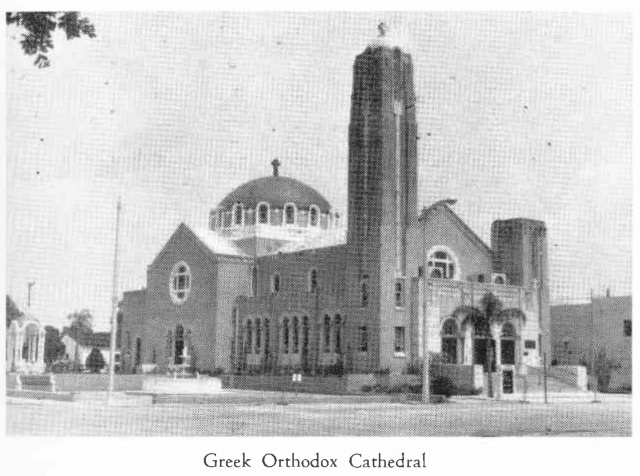 The Greek Orthodox Cathedral occupies a part of the block between Hibiscus Street and Pinellas Avenue on Orange Street. This imposing edifice has attracted visitors and tourists from many cities and states to admire its architectural beauty. The Church of God, of which the writer is now a member, stands on the corner of Pent Street and Disston Avenue. The present pastor is Reverend E. C. Bryan. Just two blocks south on Disston is the Church of Christ, and one block farther south on Disston and Tarpon Avenues is the Assembly of God, a very beautiful and colorful building. There are also a number of churches of various denominations for colored people, the oldest of which I have any knowledge is the Mount Moriah, A. M. E. Church. The present building was constructed in 1931-1933 by S. M. McBride and H. J. King. The organization is much older. Tarpon Springs offers a church home to people of all races, creeds, and colors. There are adequate facilities for those who come our way, with exception of a Jewish Synagogue. In the early days of Tarpon we had quite a bit of lawlessness and a few killings but now have a quiet, orderly city and good police force. Since we are on this subject, I wish to mention one tragedy that occurred many years ago, and resulted in the loss of several lives. On July 4, 1893, the city marshal in attempting to arrest a drunken sponger, was shot and killed. Erastus Whitehurst had led somewhat of a cowboy life before he became town marshal of Tarpon, therefore he was quite expert in horseback riding. He had just taken part in what they called “a tournament” at that time. This consisted in catching rings off of suspended cords with a pointed rod and the horse going full speed. Whitehurst walked over to the sponger, Bob Atwill, and started to arrest him whereupon Bud Stephenson, a farmer interfered. Whitehurst said, “I will arrest you too,” and then the fray began. John McNeil, a nephew of Stephenson, shot the marshal in the back, and Stephenson shot him also, and he fell to the ground. This writer was about 50 yards from the men when the shooting began but got out of range, behind a house. I was just 15 years of age. Stephenson was also shot, but was not killed at that time. This developed into a feud which continued several years and 12 or 13 men were killed, including Stephenson. This vendetta was similar to the Hatfield-McCoy affair in Kentucky many years ago. Whitehurst, like many other officers, lost his life in the line of duty. The sponger, Bob Atwill, disappeared during the confusion, got aboard a boat and made his escape. John McNeil went to Dade City and gave up, and later was given his freedom. Chapter 7 Sawmill, Ice Plant and DairiesIn 1880, N. S. Patten came from the north and built a sawmill, which was very much needed at this time. The mill was located on the Anclote River, near the Sponge Exchange, on the spot where Chris Swendsen’s sail and awning shop now stands. Of course the mill and lumber yard covered quite an area in that section. This was a great contribution to the industrial side of Tarpon Springs. It afforded employment for quite a number of men, both white and colored. Timber was cut–up and down the river–and along the Gulf coast, then brought in on large rafts or with log carts and oxen. George Turnpaw and his family, originally from Ohio, came from Kentucky, where they had been residing. 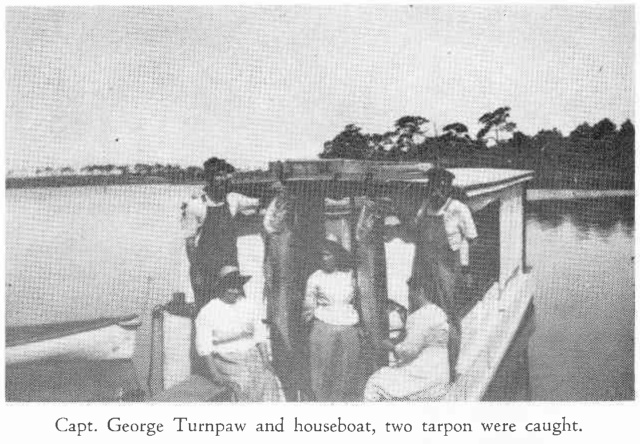 Mr. Turnpaw was experienced in sawing and machinery and under the management of Mr. Patten and Mr. Turnpaw, the wheels of industry began to hum and good lumber to slide off the roller beds to be stacked in the yard or hauled to building lots. Quite a few cottages sprang up around the mill for the housing of colored help. This settlement was known as “Patten’s Quarters.” This log boom afforded amusement for the town boys as they ran over the logs in the water. Sometimes a boy would lose his footing and slip between the logs into the water. The flow of tourists into Tarpon began to increase, so Mr. Patten decided to start another branch of industry which was very much needed. Accordingly, he used a considerable quantity of his good lumber and built a small steamboat which was then named Ellen, after his wife. He began taking parties down the scenic Anclote River and out to the lighthouse. He also built a houseboat with canopy overhead by which he could more than double his carrying capacity. So, by towing the houseboat, he could accommodate a large crowd of passengers. More lumber built another steamboat named the Joe. This boat could tow the houseboat and leave the Ellen free to go other places. These boats carried Sunday school picnic parties and could be chartered or hired for other occasions. 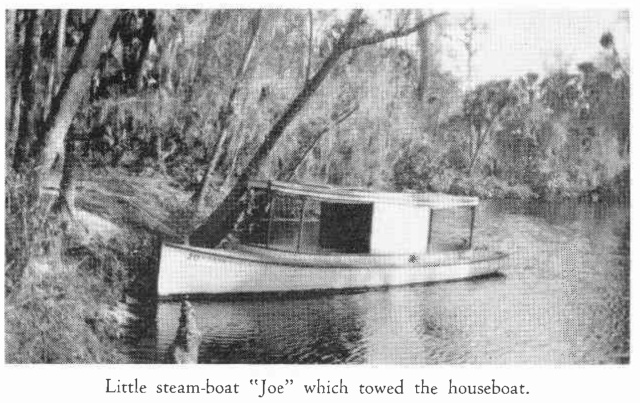 Mr. Turnpaw was not only a sawmill engineer, but a good steamboat engineer as well. He had good lumber. These two men that meant so much to the business life of Tarpon have long since passed on. There is one lone survivor of the Turnpaw family left–James Turnpaw, who owns and operates a marine ways on the north side of the Anclote River. He is 85 years young, keen and alert, and has a wonderful memory. He has a younger sister who resides in Tampa. ICE PLANT The first ice plant of this city was located on the river bank, west of the disposal. Mr. Weller, we believe, established this plant. A family by the name of Swet came from New Jersey and Mr. Swet became the machinist in charge. Swet’s father and brother also came and were employed in various ways. The elder Mr. Swet was one of those unforgettable characters of whom we wish to say more. He was an “old salt” from Down East and seemed utterly fearless on the water, upon which he had spent most of his life. 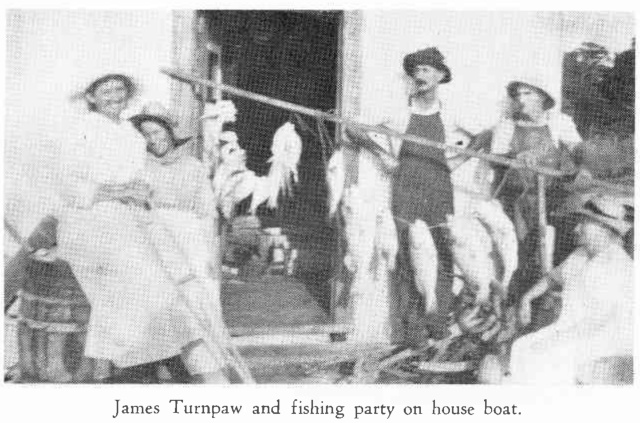 There was a little red schooner here, not too seaworthy. This old captain proceeded to man this little craft with anybody he could hire for a crew. He was not thinking much about deep water and high seas when he took these inexperienced land-lubbers out onto the wide open sea. In order to catch Grouper and especially Red Snapper, it was necessary to go into deep water. This was the crux of the situation. Those boys would at times get seasick, but that wasn’t the worst of it; they were watching the barometer all the time and would continually remind the captain, saying: “Cap, it’s goin’ down.” One day Cappy got tired of this and going below, he grabbed the barometer and with a few epithets, threw it overboard, saying, “Now it’s going down.” Needless to say, this brave “old salt” and his unseasoned crew never had any serious trouble. Sometimes this little craft’s decks were awash, but she always came back. His son, Harry, and grandson, Eddie, probably never gave him any trouble as they were “chips off the old block.” 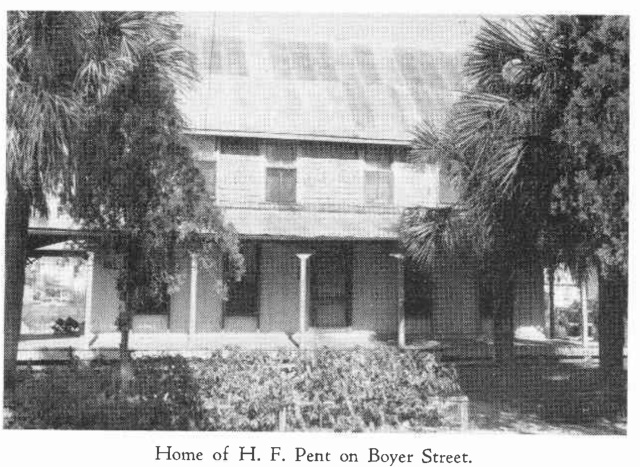 How long Captain Swet continued to deep-water fish in the boat Red Grouper, I don’t remember. He never stayed very long at any job; in fact, jobs were not so numerous in those days. After some time, this hardy old sailor became the town marshal. Everything seemed to go well, but one night about 7:30, to my surprise he accosted me on the street. “Bob, come with me,” he whispered. Handing me a .44 or .45 revolver, he continued. “A Negro has broken out of jail.” We went to the river where they usually caught a boat to go aboard a sponge vessel. We stepped into a boat, which was partially decked over, a good hiding place. I stooped down and looked under while he held the match (we had never heard of a flashlight). To my satisfaction and his disappointment, there was no Negro there. I don’t remember what became of the Swets. They probably went back North. Eddie died in Cedar Keys. DAIRY The first dairy of which I have any recollection, was located between West Lake and Morgan Streets, west of the Cities Service filling station. This dairy was owned and operated by D. S. Buchanan, or Dannie as he was always called. This was about 1886. He also had a nice truck garden and helped supply the town with vegetables. Mr. Buchanan married Mollie Jones, the sister of Rube Jones and this union brought two sons, Arthur and Rader. Dannie peddled milk with his horse and buckboard and ladled it out of a large milk can from door to door, as I remember, ten cents a quart. This part of town was very low ground, especially west of Pinellas Avenue. When this street was graded south, deep ditches were left on each side and naturally filled with water. I have stood on the board sidewalk and caught small perch which grew in those ditches; I also caught two small black bass out of a hole not far from where the Pick Kwik grocery store now stands. These details may seem of little importance to some, while to others, it is interesting to know the change of landscape and removal of obstructions as the town progressed. My father had moved from the old homestead on the river, and settled in his new home on Boyer Street in 1885 so I grew up with the town. Getting back to dairies, Sam Boyette, who bought out Mr. Buchanan, owned and operated the next dairy on a larger scale. This one was located on South Grosse Avenue, near Boyer Street. He also built a nice home near the same place; the old building is still standing. Mr. Boyette married Miss Mattie Lyons and to their marriage came two sons and three daughters. William Boyette lives at Lake Tarpon and his son, Irving H. Boyette, a building contractor, lives at 426 Cypress Street. The next dairy was owned and operated by Mr. and Mrs. Peter Kapsalis on North Pinellas Avenue. These people were in business for several years, but have long since ceased to operate. 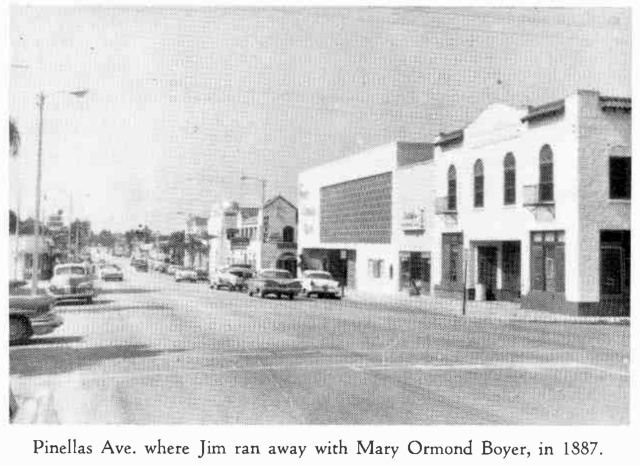 Since Tarpon had grown from a village to a town, business activity had shifted from West Tarpon Avenue to the central and eastern part. People were now depending on Tarpon for supplies instead of going to other places. As yet there was no pavement on Tarpon Avenue or any other street. All the sidewalks were made of boards, laid cross-wise and sometimes, length-wise, which created a hazard for bare feet. Well do I remember this as a boy. When two people were walking together, one would sometimes step on the end of a loose board, throwing up the other end, and trip his companion, sprawling him in the street. The constant traffic of wagons, buggies and carts, coming from the country, and hauling lumber from the sawmill and groceries from the dock, cut the sand very deep and made traveling difficult for loaded vehicles. I recall Mrs. Mary Ormond Boyer, who had a spirited buggy-horse, named Jim. Jim became frightened, perhaps from her umbrella, and down sandy Pinellas Avenue they went, amid the flying sand, Mrs. Boyer trying to hold the reins with one hand and the umbrella with the other. Finally, she lost the umbrella and brought Jim to a halt farther down the street. Chapter 8 Doctors, Undertakers and PrintersI have mentioned the physicians of Tarpon on a previous page, but wish to continue this subject for a brief space. Miss Mary Safford was the first resident doctor of Tarpon Springs. She was small in stature, like her brother, but quick and alert. When I was a boy my parents called upon her to perform a little surgery on my foot which was giving me trouble at that time. We do not remember how long this tiny little woman administered to the needs of these people, but she went the way of all the earth and her remains rest in Cycadia Cemetery. Dr. Rosenburg practiced here for a short time. His office was on the south side of Tarpon Avenue and his services gave us quick relief, once when I greatly needed a physician. Dr. Douglas, my mother’s physician, made his contribution to the needs of Tarpon. Mrs. Douglas also added her part to the medical profession, by discovering a medicine, the application of which would remove skin cancers. Claude Douglas, his son, passed away at Anclote a few years ago. Dr. Hilliard and Dr. Morgan were also one-time physicians at Tarpon. Dr. Hilliard was followed by Dr. A. P. Albaugh of Ohio who came down and looked over the situation. He, like L. D. Vinson, saw in this attractive city a good place to have a home and spend the remainder of his life. Dr. Albaugh immediately sent for his wife, son, Estin, and daughter, Iva. Though Tarpon had acquired a reputation for a healthful climate, the doctor soon found the people here needed medical attention as well as other places. The Albaugh family was quite an asset to the religious and social life of Tarpon. Dr. Albaugh was a steward and trustee and Sunday school teacher in the Methodist Church. The other members of the family participated in some branch of church activity. Miss Minnie Roof, the sister of Mrs. Albaugh, was a school teacher and contributed her part to the educational system. In those horse-and-buggy-days, I remember taking a long trip into the country to a turpentine still, where doctors often administered to patients. Estin Albaugh, a special friend of the writer, married Miss Hildreth Meyer, my cousin and now resides in the old home on Cypress Street. Since mentioning so many earthly physicians and their benefit to humanity, it would seem like a breach of faith and loyalty not to mention and honor the Great Physician, who has come to our rescue when it seemed all else had failed. Yes, I have been healed and restored to health by faith and prayer, and attribute longevity and good health at 86 years of age to the Grace and Mercy of the Great Physician, Jesus Christ. UNDERTAKERS First undertaker in Tarpon was D. J. Murphy; his place of business was on the southwest corner of Pinellas Avenue and Lemon Street, where the cocktail bar of the Arcade Hotel now stands. Mr. Murphy also built the first Catholic Church, which was just west of the bank. He was not a modern undertaker, but sold coffins and took care of the dead in a primitive way. 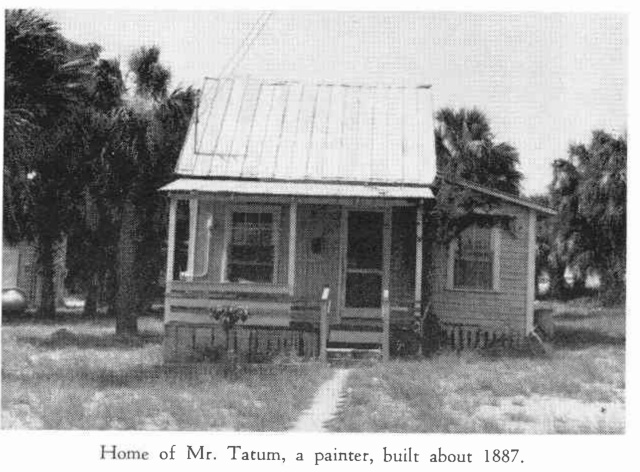 L. D. Vinson came to Tarpon Springs from Georgia. Mr. Vinson soon saw that although Tarpon had a wonderful climate, people died here much the same as elsewhere so he began planning for a larger and more modern business. At the passing of L. D. Vinson, the business went into the hands of his son, L. K. Vinson, who carried on for many years. His first undertaking parlor was on Orange Street. In the meantime, the Vinson business became better known and better equipped. It has been said that when Vinson’s get through with a corpse, it looks very natural, and asleep. The genial, smiling Gene Vinson, who carried on in his father’s place, is well known in upper Pinellas County. The funeral home, which has been on East Tarpon Avenue for many years, has had an addition of a nice, modern chapel. PRINTERS The earliest recollection we have of any printing done in Tarpon Springs was a little paper edited by Mr. Brown, on the corner of East Tarpon and Grosse Avenues, about 1886. This was quite primitive in its operation. The type was set as any other paper, on a level surface, the size of an average newspaper. The ink was spread on, then the paper was carefully laid on and a roller about three feet long and ten inches in diameter, covered with heavy cloth, was rolled over the paper. This little paper never had a very wide circulation, but afforded means of advertising for the few businessmen and gave the citizens quite a bit of news. I don’t remember the name of this paper, nor how long it continued to be printed. The next paper was the Tarpon Springs Truth, edited by George Truax. This paper continued in circulation for some years. Mr. Truax married Miss Winnie Murphy and lived here with his family many years. Once a turkey was raffled off and Mr. Truax bought a ticket, but not being a very good marksman asked me to shoot for him. I won the turkey but never had a chance to eat any of it. Since we had but one hard surface street, riding bicycles became a favorite pastime for the young people. We also had many board sidewalks, which sometimes proved treacherous. Mr. Truax, with a number of other public-minded men, conceived the idea of constructing a bicycle road to Wall Springs and Lake Tarpon. The writer, being 18 years old, was employed on this project. The paving was for the greater part, pine straw, and lime rock which were plentiful and cheap. Mr. Truax sold out and went away. Will Gore of Clearwater, was another editor, also Lucian Lucas of Cedar Key. Then Harvey Polk, brother of Mrs. Leandro Safford, who was from Chicago, took the position. The next, as we remember, was Mr. Converse of Elmira, New York. There was a period of several years between the Spanish-American War in 1898 and the time I became married in North Carolina in 1910 that I was only here part of the time. However, the following is basically correct. Mr. Angel followed Mr. Converse, and then Mr. Tiddy took over. There was a period in which things didn’t go too well and the paper went into bankruptcy. The town was not disposed to do without a paper, so, a number of businessmen, including Abe Tarapani, formed a syndicate to finance and operate the paper. Mr. Mann did the arranging of news and editorial work. Major J. H. Hennig came to the rescue in 1922 and took over the Leader, its present name. Mr. Mann continued to work on the staff until he retired a few years ago. Under the able management of Major Hennig, the paper got on its feet. Before letting Mr. Mann go, we wish to hand him this bouquet. He was an excellent proofreader, and when anyone was at a loss for a word, the spelling, or definition, Mann could always come up with the answer. In later years Major Hennig and Mrs. Helen Hennig, took over and ably managed the Leader, Major Hennig edited the paper until his health became poor; then his wife, Mrs. Helen Hennig, took over and ably managed the Leader until 1962, when George William Averill became editor. 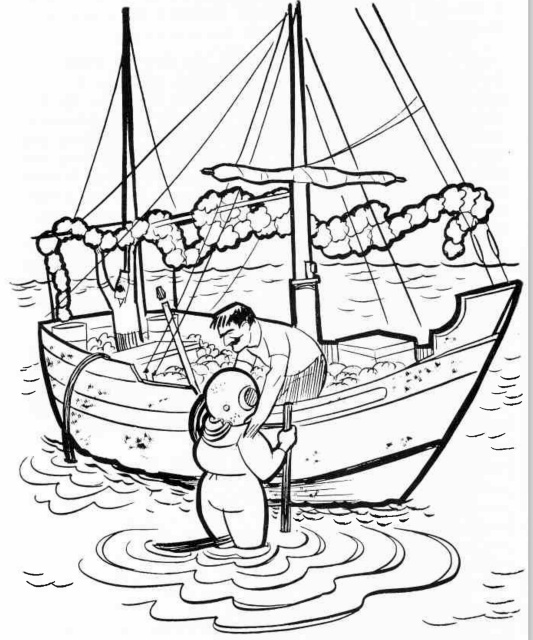 Chapter 9 Sponge BusinessThis interesting and somewhat lucrative business can be approached from several angles, as there is some difference of opinion as to who did what and when. We are very well acquainted with sponging from it’s infancy here. The Mediterranean Sea is perhaps, the first field for harvesting sponge, of which we have any record. Sponges have been gathered off the Florida Keys, by people of Key West as early as 1870, perhaps earlier. My father was born at Key West in 1849 and lived there until he was 25 years of age. Although my father was a carpenter, mechanic, and experienced boat caulker, he sometimes resorted to sponging for a livelihood. The earliest method of gathering sponge was with long poles having hooks attached to the end. These poles were made out of good material of straight grain and were from 15 to 40 feet in length and about 1 1/2 inches thick. One man leaned over the side of the boat, looking through a water-glass for sponge, while the other man sculled the boat with a long oar. When the water is clear, it is very fascinating to look at the formation of rocks and coral and beautiful sea feathers on the bottom. These spongers may never have explored the art galleries, nor viewed the works of great artists, but they had abundant opportunity to behold the handiwork of the Creator. The great variety of fish, and other living creatures of the deep, lend to the enchantment of the scene. The sponge off the Gulf coast of Florida are of better texture than those among the islands around Key West, so sponge vessels began moving this way. They usually stayed out on a trip five to seven weeks, unless hindered by bad weather or other causes. It was necessary for the water to be very clear in order to harvest sponge by the hook and pole method. The average depth for hooking sponge was from 12 to 30 feet, but sometimes the water was clear at a depth of 40 or 45 feet. It was then the spongers were really happy. They got more, larger and better textured sponge, for which they also received better prices. There were three kinds of marketable sponge: Grass, Yellow and Sheep’s Wool. The latter was, by far, the most valuable. The Florida Sheep’s Wool is the best in the world. The Glove Sponge was a variety which was very beautiful, but scarce. Sponging began on this coast about 1873, perhaps earlier. It was necessary to store their sponge until they were ready to take the entire catch to Key West, so the first place was on North Key, one of the Anclote Keys. Two men, Mr. Sawyer and Mr. Baker took care of them until they “broke trip.” On Friday afternoon the vessels usually came in and deposited the week’s catch in kraals. The kraals were enclosures eight to twelve feet in length and six to eight feet wide; made by driving poles or the trunks of small trees into the ground in shallow water. The sponges soaked in the water and were ready for cleaning the next Saturday. Dying sponge on a vessel’s deck created an offensive odor, but the men became accustomed to it. After a few years the kraals were moved from North Key to Baillie’s Bluff, where they remained. In about 1886 a large sloop, named the Glance, appeared off the West Coast and gathered sponge by the diving method. She carried a Greek crew. We don’t know where they marketed their sponge. Apalachicola later became a sponge port, but never reached the proportions of Tarpon Springs; in fact we were considered the largest sponge port in the United States and perhaps in the world, for the gathering and processing of sponge. John K. Cheney, who was one of the Lake Butler Villa Company, also became interested in the sponge business and in 1890 began buying sponge. My father saw the need of a marine ways and having had experience in shipyard work in Key West, began making preparations by building a ways for the purpose of taking care of sponge boats, when they needed reconditioning and painting. As the business continued to expand, a great deal of the buying and packing shifted from Key West to Tarpon Springs. This naturally caused a keen competition between the buyers of other places. Naturally there was a fleet of vessels purchased and equipped here. Baillie’s Bluff became a center of great activity. The boats from Key West, Apalachicola and Tarpon deposited their sponge there for safekeeping. There arose a great need for handling mail, so a postoffice was established and named Security. Otis Baker was the postmaster. Many of the Key West boats sold their sponge here, if the buyers gave them better prices. Packing houses were built, sponge presses were installed and Tarpon was well on her way to becoming the greatest sponge port in the United States. W. W. K. Decker came on the scene and became one of the important sponge buyers. John K. Cheney, not being familiar with sponge buying, sent to Key West for William Roberts, who was an experienced sponge buyer and well acquainted with processing and packing. Mr. Roberts was really the first sponge buyer in Tarpon. The Roberts family came later and made Tarpon their permanent home. Most of them have long since passed away, but Mrs. Daisy Curry, one of the younger children, resides on East Tarpon Avenue. Mickey Roberts, a grandson and assistant postmaster, resides on Boyer Street. Mr. Cheney not only handled a large part of the sponge business, but was one of the real estate syndicate known as the Lake Butler Villa Company, which controlled and sold a large amount of acreage. Many of the old deeds and abstracts have this familiar name on them. The Rock Island Sponge Company played quite a part in this business but I do not remember who their representative was. Mr. Rouge and A. P. Beckett came from Apalachicola and with Mr. Louden from Philadelphia, participated in the sponge business. The reader can easily see that the sponge business here was assuming mammoth proportions. Mr. Arapian, a Turk, who had married an American girl and was living in Key West, was engaged in the sponge business and came to Tarpon with a small fleet of sponge vessels. Mr. Arapian put up a packing house on the south side of the river and my father, H. F. Pent, built a marine ways to take care of his vessels. As the business continued to grow, other buyers appeared and began to participate in buying sponge. They were Leon Fernald, Ernie Meres, Arthur Pinder, H. Joe Smith, Frank Fernald and Sanberg, all were Americans except Arapian and Sanberg. Mr. Cheney and others bought at Baillie’s Bluff. All of the buyers mentioned were Americans except two. The Asa Lowe, owned by Mr. Cheney, was the prettiest model of all the Tarpon boats, but the Silver Spray, also owned by Cheney and skippered by Captain John Brady, in my imagination, was queen of the fleet. My first venture in sea life was on this noble-looking vessel. I was too young and small at this time to ship as able seaman so I was the cook’s helper. Coming from a sea-faring family, on my father’s side, I was eager and ready to get on the water. The tales of adventure between Key West and Cuba, told by my father, also his life as a wrecker on the Florida reefs, built up within me an insatiable desire to try my hand with old Neptune. Of all the pleasant and happy days spent on this vessel, one outstanding day will never be erased from my memory. We were sponging on St. Martin’s reef when a heavy southwester came down upon us. I don’t know how many boats were in the fleet, but they all scudded for harbor except two; the Alafia skippered by Harry Sweat, and the Silver Spray. The crews of both vessels were from Tarpon or Anclote and possibly a nostalgic urge caused them to start for home. I don’t know how the little Alafia made it but the Sweats were like the McCrearys–it took a stormy sea to turn them back. From the time we weighed anchor on the reef, until we dropped anchor at the mouth of Anclote River, that noble vessel staggered through heavy seas and under reefed sails. It was a wonderful day. We changed clothes three times because of the waves that washed us from stem to stern. It has been said that variety is the spice of life and this experience really put the tang to it. Getting back to the sponge industry, things were really booming around Tarpon. A sponge village sprang up on the south side of the river, known as Sponge Harbor. W. W. K. Decker built a two-story house. A general merchandise store occupied the lower story and his family lived upstairs. A long dock was built out to the channel for the convenience of boats. My father put up his work shop and moved his marine ways to this spot. Cottages were built for spongers and their families; a packing house was built for the processing of sponge. Activities shifted from Anclote on the north side to Sponge Harbor on the south side. All that has been written so far concerning the sponge business, was accomplished during the pole and hook method. John Brady, captain of the Silver Spray, resided at Sponge Harbor, at this time. He probably came from the Bahamas West Indies by the way of Key West. He was of Irish descent. He married Miss Amelia Frierson of Hudson and to this couple were born four sons and two daughters. Captain Brady has long since passed away, but there remains a host of grandchildren and great-grandchildren to perpetuate his name. A variety of craftsmen have evolved from this sturdy old Irishman–boat builders of which James Brady, a grandson, is one of the best in and around Tarpon; carpenters, cabinetmakers, and contractors, of which Ivan Brady is well known. One highway patrolman, Leonard Brady, is a great-grandson. Sponge Harbor thrived for a while, but the ever-shifting scenes of industry thrived into other phases of operations and moved to other places on the Anclote River. Sponge Harbor has disappeared; the long dock which went out to the channel is gone. The cottages have either been sold and moved or torn down. The sponge house and marine ways have long since given place to small trees. The store and dwelling of Mr. Decker has disappeared. I was there a year ago and nothing remains but scrub oak. The Anclote Manor hospital stands a few blocks from where this building was. Mr. Decker later put up a packing house at Anclote. This writer has worked in six of the houses already mentioned. DIVING In 1907 Johnnie Cocoris, a Greek, came to Tarpon Springs. He was the first to initiate the diving method of obtaining sponge. In the meantime, Mr. Cheney conceived the idea of getting more and better sponge by diving in deeper water. So he began sending for Greek divers. Obtaining sponge by the hook method was limited to a depth of 45 or 48 feet and the water had to be very clear. A southwester could stir the water in a few hours to where it would be impossible to see a sponge through the water glass. In the depths beyond, there lay a vast field of unexplored wealth, and only the divers could reach it. Then too, deep water sponge brought better prices. 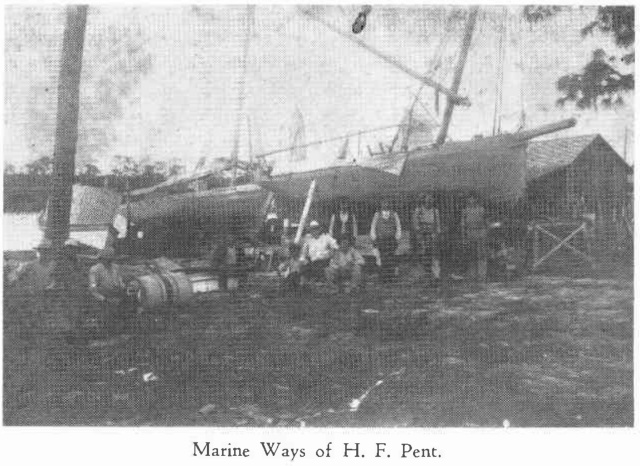 An experienced sponge buyer could tell immediately where a sponge was gathered–on the reef, Rock Island, or deep water. The sponge industry was in for a face-lifting. Divers came from Greece and from the Dodecanese Islands; foreign faces began to appear and foreign voices were heard on the streets. Some of the hook boats began to equip themselves to accommodate divers. My father again built a marine ways at what is now called the Sponge Exchange docks. He prepared the first diving boat that went out of Tarpon. Soon, a shipyard was started for the building of a different type of boat, suited for deeper water and diving equipment. A few hook boats have remained until now but the great fleet of pretty boats from Key West gradually disappeared. There was a scourge of poison water that appeared on the West Coast and threatened to annihilate the sponge business; and did hinder it seriously for awhile. Thousands of sponge were killed or rendered unfit for commerce. After a while it disappeared, leaving the sponge beds almost bare. Many of the boats sought other means of making a livelihood, such as deep-sea fishing. Some were sold and taken to other places. Gradually, the business recovered from this blow, but never quite reached the same volume that was carried on before. Instead of taking the sponge to Baillie’s Bluff for safe keeping, or the Union Kraals, which had been made at another place, an enclosure was built at Tarpon Springs on the river front, known as the Sponge Exchange. There they are stored until sold. The Sponge Exchange is not only an enclosure but an organization of which Lewis Smitzes is the President. About all of the sponge buyers now are Greek; some of which I will name. S. B. Katzaras, Samarkos Brothers, George N. Arfaras, Hagi Company, Florida State Sponge Company, Gus Cocoris, Smitzes Brothers, and Charles Galernos. Some sponges are sold and packed at Key West and a few are marketed at Miami. The sale of sponges along the riverfront has developed into a far more attractive business. Many curio shops have been built and literally stacked with beautiful shells, and other denizens of the deep. They are cured and mounted in a pleasing way so the thousands of tourists, who flock along Anclote Boulevard, will have no trouble in selecting gifts and souvenirs. Some of the specimens come from the Gulf of Mexico but thousands are imported from the Mediterranean Sea, the Bahamas West Indies, Japan and other places, perhaps the Caribbean Sea. Chapter 10 Incredible Incidents of By-gone DaysAs I reminisce over the past years, many incidents come to mind–some humorous, some tragic, and some fraught with tender memories. Once as a teen-ager, I visited a place over in Pasco County, with a friend by the name of Braddy Carraway. This church and school house was called Vereen. I do not remember if there were any other houses in this vicinity, but I do remember the children playing at recess. Among this group of tots and teen-agers was a slender, fair-faced girl, whom I have always regarded as a heroine. She had the misfortune of being caught in a gun episode one night. A band of determined men came to finish off her father, who had been previously wounded in a gun battle. Her uncle was killed this night and her father wounded again. She displayed great courage and coolness at this time. She was none other than Cora Stephenson. Some years later she was married to Gip Brown and the last time I saw her, she was a happy, healthy woman. I am not sure that she is living at this time. Those were the feudal days, in which angry men took the law into their own hands and settled differences with gun fire. I am not a believer in mob violence, or unlawful killing, but I wonder how far today’s teen-age orgies and vandalism would get at that day and time. I visited Vereen some time ago and not one vestige of a house could be seen, not even a sign that one had been there. Nothing but grass, scrub oaks and trees. A few tombstones, most of which were weather-stained, reminded one that people were buried there. No one would think that happy children laughed and played on that land or that the Gospel message rang out from a pulpit of those bygone days. It seems rather strange that no one cared to build a home on the same spot where those pioneer houses stood. At Anclote, there is only one landmark remaining of all those pioneer homes. At the back porch of the home of Capt. Sam Hope, a concrete cistern was built to catch rain-water. All the wells were from eight to twelve feet in depth, according to the elevation. The house has long since disappeared. Some one planted banana trees in this old cistern. A photo will probably be in the front pages of this book. My father bought a sloop named the Breeze in which he sometimes went to Crystal River for a load of oysters. The bars off the mouth of Crystal River furnished tons of oysters of the finest quality. This little sloop was not particularly suited for deep water and heavy seas but my father was a sailor, even from boyhood, and could handle boats in all kinds of weather, so the little Breeze was his main dependence for coastal travel. One day with a good store of food aboard, my father set sail for the oyster bars, about 65 miles away. Dad was caught off his guard by a tricky gust of wind and overturned off Horse Island, near Hudson. It was rather a helpless plight for one man but Capt. John Brady, who was on another vessel, anchored not many miles away, came to his rescue. I chanced to sail with this same captain on the Silver Spray some ten years later. My uncle, Gus Meyer, Captain Topliff, and Taylor Youngblood were on their way to Cedar Keys in the sloop, Florence. Some time after nightfall they encountered heavy weather off St. Martin’s Reef and were overturned. Just how long they clung to that boat, I do not know, but Captain Topliff, getting tired of the situation, decided to go for help. Taking a large oar for support, he started for shallow water, which extended a few miles out on the reef. They never saw him alive again. He was a brave old man. His body was found, weeks later, washed up on the shore. He was a good sailor and had sailed the seas on larger boats for many years. The other two were rescued by a sponge boat. Strange as it seems, my Uncle Gus bought this same boat and used her as a hook sponge vessel. I went as cook on the first trip. The beautiful, blue waters of the Gulf of Mexico, which have afforded much pleasure to boat parties, fishermen, spongers and boat races, has been the scene of many tragic events. Harry Lever, who later became my brother-in-law, and Dave Hope, the youngest son of Capt. Sam Hope, started for Crystal River on the Sparta for oysters. Lever was below preparing breakfast and Dave was at the helm. Suddenly the schooner luffed up in the wind and Harry, looking out, saw Dave drifting astern. No one will ever know how it happened. Harry tried in vain to rescue him, even getting close enough to throw him a rope, but he sank beneath the water, never to rise again. Harry Lever came back to Anclote and, with a party of men, including Ed Hope, Jim Hope, Wyatt Meyer and myself, went in search of him. For hours we sailed the waters where he was last seen but to no avail. It was a terrible blow to the family and friends, but such is this life. A few years ago an incident occurred on the Anclote River, which is well worth recording. Edgar Sapp, a commercial fisherman and a friend of mine, was coming up the river to put his boat on Turnpaw’s Marine Ways, when just east of the Chemical Plant he discovered a woman floundering about in the water. She had either jumped or fallen from a small boat drifting nearby. Sapp ran his launch close to the place where the woman disappeared, cut off the engine, and prepared to dive overboard. There lay the body, beneath the mucky waters, eight or nine feet deep. Sapp plunged in and brought the woman to the top, but was unable to hold her. She was a large woman. By diving and pushing her toward the shore, he finally reached shallow water, where he could stand and keep her head out of water. In the meantime, some others had seen the situation and came to the rescue. She was given first aid treatment and regained consciousness. Dr. Clough was summoned, and she was taken to the hospital for further restoration. It takes a real man to handle a situation like that. It is a tough job if you have on a bathing suit but to tackle it with your clothes on is worse. The man and his wife never seemed too appreciative of this noble deed but finally, after a long time, replaced his watch that was ruined by the salt water. Edgar Sapp is a member of the Church of God, assistant Sunday School Superintendent, on the official board, and a trustee. The first fire engine in Tarpon Springs was a very primitive affair. It had a tongue like a wagon, and could be drawn through the sandy streets with a long rope attached–and lots of men and boys. It was hand pumped, and probably used some chemicals. I can’t recall any instances in which it was used. One day while working in A. P. Beckett’s sponge house, I started home for the noon day meal. Near home I overtook a group of men and boys toiling up the sandy road, dragging the little fire engine. On inquiring what it was all about, I learned that it was my house afire. The engine was stuck in the deep sand, but after considerable tugging and pulling, it was on the move again and arrived at our house a few minutes after the fire had been extinguished by the quick action of friends. The fire was in the kitchen between the ceiling and the roof. Mr. Griffin, a neighbor from across the street, ran in and seeing a bowl of starch, grabbed it up, and let go at the ceiling. Of course, most of the starch fell back you can imagine how the rest looked on the ceiling. Mr. Coons ran up a ladder from the outside, and tore off shingles, in order to pour in water by hand. Mother was upstairs sick in bed and father was away at work. My sisters bore the brunt of the excitement. In the early days of Tarpon, the men and women kept abreast of the social and recreational functions as well as the industrial and political trend of the times. One night there was a social affair at the Tarpon Hotel, possibly a grand ball. Of course, it was well advertised, by way of the grapevine, and all the young sports, and socialites were looking forward to a gala affair. The night arrived and everybody was on hand, dressed for the occasion. The young men from Anclote and possibly other surrounding communities were there. Everyone had a good time until refreshments were served. At that time cochineal was used to give ice cream a delicate, rich color and they used it in an overdose. We don’t know how soon after the fun began, but the people began to act like a party of seasick fishermen on a deep-sea fishing trip. Of course the party broke up and couples started for home. Ladies, leaning on the arm of escorts, became so nauseated that they were overcome in the street. My uncle, Wyatt Meyer, happened to be in one such dilemma. It was an awfully embarrassing situation. The young men tried to be as gallant as possible, but they too, had the same symptoms. That was a party long to be remembered by the young people of Tarpon Springs. No doubt cochineal was banned from that time on. A somewhat amusing but serious episode occurred at an old house on Boyer Street during my boyhood days. Mr. Parson, the owner, went north during the summer months, returning again in the fall. At that time hoboes would come south to avoid the cold weather, and beg for handouts. One of such caliber gained entrance to this house, and was living on donations from the neighbors and oranges from the adjoining grove. Mr. Edwards, the father-in-law, came a little early and upon entering the house was confronted by the hobo, gun in hand. The old gentleman ran out yelling, “Thief! Thief.” Mr. Platt, the marshal, and Pat Miller were quickly notified and a chase began. The hobo escaped through the back door, or window, ran through the orange grove to a swamp, south of town. Some shots were fired, but none took effect. The swamp was surrounded and set afire. The hobo was found and arrested in a pool of water in the middle of the swamp. He was hand cuffed and taken away under custody of an officer. Well, they still come this way and add to those already here, who are more interested in banks, chain stores, filling stations and jewelry than oranges and hand outs. In 80–or more–years only two officers have lost their lives in Tarpon Springs while in the line of duty. E. W. Whitehurst was shot July 4, 1893 while attempting to arrest Bob Atwell and Bud Stevenson. Officer Blewfield was killed in 1925 while attempting to stop thieves from robbing a grocery store. Chapter 11 The PioneersANTONIO HERNANDEZ The Spaniards, among the first of European nations for explorations, conquest and colonization, played a major part in settling the southern part of the Western hemisphere. Such well known celebrities as Desoto, Ponce DeLeon, Balboa, Cortez, and others, made their contribution to the Latin American countries and the greater Antilles. We do not, however, commend some of their methods in dealing with natives. They brought a better form of civilization and opened up the new world for greater things to come. Ponce DeLeon, in seeking the fountain of immortal youth, came to Florida, but being disappointed in his findings, turned southward among the islands. St. Augustine was settled by the Spaniards in 1565; forty-two years before the first permanent English settlement was made at Jamestown, Virginia. Thus began Spanish culture on the east coast of Florida and giving St. Augustine the distinction of being the oldest city in the United States. Many of the Spaniards, who settled on the east coast of Florida, were from the island of Minorca, consequently, they were called Minorcans. Many of the Greeks who came to Tarpon Springs were from the Dodecanese Islands and not the mainland. Key West was settled by the Spaniards and a few have settled on the West Coast and among the islands. Some towns and coastal waters have Spanish names. Many stories have been told of pirates and buccaneers on the Spanish main and much effort has been made to locate fend unearth hidden treasure, supposed to have been buried on the islands and along the coast. A poetic and romantic atmosphere has always lingered around Spanish songs and music. The sweet exotic strains of Spanish music has thrilled me many times in my youthful days. The Spanish guitar was once my favorite instrument. “Juanita” was often sung by my sisters. The Mexican National Anthem, “La Paloma,” The Dove, and “Sobre las Olas,” Over the Waves, has thrilled me many times. To me, the Spanish language is the most beautiful of all languages. My tendency toward these things is enhanced by the fact that my ancestry on my father’s side dates back to old Portugal. Also, my childhood was environed a bit by Spanish culture and stories told by my father. Getting back to my subject, some time in the late 1830’s a Spaniard by the name of Antonio Hernandez came from the old country and settled on Maximo Point, now Pinellas Point, at the mouth of Tampa Bay. Maximo, in Spanish, means very great. Mr. Hernandez became involved in the Seminole Indian War, which was being waged at that time, and for his services was accorded a “land grant” by the government which included Maximo Point. In 1830 a terrible and devastating hurricane swept over that section, doing much damage to Maximo Point and the surrounding country. Mr. Hernandez married, and to this union a son and daughter was born. The daughter married another Spaniard by the name of Gomez–and moved to Key West. The son, who was also named Antonio, went to live with his sister in Key West and being a small boy, finally acquired the name of Gomez. Like all Key Westers who loved the water, Antonio Gomez, as he was called, began going to sea. There was a fleet of fishing smacks which sailed out of Havana, 90 miles from Key West, so Tony could have his choice between those that sailed out of Havana and the smacks and spongers that sailed from Key West. In the meantime, Tony married and one daughter was born but tragically he lost both. Since Key West no longer possessed the charms of home life, Tony sought his fortune elsewhere. So, shipping on a sponge vessel, he began life on the West Coast of Florida. If a human has talent or ability in any field of enterprise, it soon becomes evident to those by whom he is employed. Accordingly, Antonio’s aptness as a sailor and ability in handling a sailboat was made known to the owners of sponge vessels and soon Antonio became Captain Tony. In the course of events, Tony drifted into Hudson and became acquainted with Miss Virginia Lang. They were married and for a while made Hudson their home. To this marriage there was born one son and three daughters. Jobs were not always plentiful at Hudson so Tony moved about some. Coming to Anclote, he continued his career as a sailor. He was Captain of the Lapulia, a sponge vessel owned by W. W. K. Decker, and also the Rosina, a larger vessel, owned by the same man. Two men of equal ability, strength and training may act the same, up to a certain point in an emergency, but when the zero hour comes they are quite different. Once when the Rozina was hit by a summer squall, she was lying on her side, about to sink. The dinghies were sunk and some of the crew were about to panic. Captain Tony was standing aft, his arm across the main boom, presumably giving orders, seemingly cool and expecting the worst. The intensity of the wind ceased and the Rosina came up again. Captain Tony lost his wife and after a few years married Miss Allie Smith of Hudson. To this union there were born two sons and two daughters. From these two marriages there were 26 grandchildren, 42 great grandchildren, and 24 great great grandchildren. Captain Tony was a well-known figure around Hudson, Baillie’s Bluff, Anclote and Tarpon Springs. After being called Gomez so many years, it was difficult to retrieve his right name Hernandez, but through the efforts of his grand-son, Willie Hernandez, they have wonderfully succeeded. The remains of Captain Tony lie in the cemetery at Hudson. PATTERSON Among the many pioneer settlers which have been previously mentioned, here is one of outstanding quality and should be of great interest to the readers. Martin D. Patterson was born in Florida in 1845 and moved to Keystone Park in Hillsborough County, after the close of the Civil War, probably 1866. He married a widow, Katherine E. Stone, June 23, 1866, who was from Texas and had one daughter. Her maiden name was Perkins. Mr. Patterson was a veteran of the Civil War and, like many discharged soldiers, was seeking a new home in the wilds of Florida. To this union were born five sons and one daughter. From these five sons there were 18 grandchildren, 63 great-grandchildren, 65 great-great-grandchildren, and 13 great-great-great-grandchildren. Several are living here in Tarpon. It is interesting to know that his wife’s mother was the first postmistress in Hillsborough County. The postoffice was in the home of Mrs. Perkins in Tampa. There were only three or four homes in Tampa at that time. We are not sure if this included Fort Brook or not. It took weeks to bring the mail from Jacksonville to Tampa. Since the woods abounded in game, the Patterson boys readily became nimrods, especially John and Will, who kept the family supplied with meat. Many times have we sat and listened to Uncle Billy as he told an interesting story about shooting deer and turkey. There were many whooping cranes in the woods and were considered about as good as turkey. Doley Patterson, the youngest son, told me about a battle he had with one of those large birds after it was wounded. These birds have long since left these parts and are almost extinct. They are carefully protected now by the law. I had one shot at a whooper, but failed to get him. They made a rather peculiar sound while flying through the air. It was not unpleasant to hear. The interest these pioneers had in church and Sunday school is well established by the fact that Mr. and Mrs. Martin Patterson walked four miles on Sunday morning to the Keystone Methodist Church each carrying a child in their arms. She taught a class after getting there and walked back home, unless some neighbor with wagon or ox-cart happened to be going that way. What a travesty on people who pretend to be religious and won’t walk, or even drive, a few blocks to church because of the weather, or because of feeling tired. And think of those who allow an atheist to forbid prayer or Bible reading in our public schools, when our forefathers suffered much to bequeath us these privileges. Mr. Patterson’s home was a kind of “stop-over” for those going from Tampa, or other places, on their way north to Elfers, Port Richey, or Hudson. Those “old-timers” would be invited to hitch their horse and have dinner. I saw the remains of this old home a few years ago. Mrs. Thomas, a granddaughter, was telling me of a little child, two years old, who strayed from home and was eaten by an alligator. They found one arm and a garment in a near-by pond. I don’t remember whose child it was. 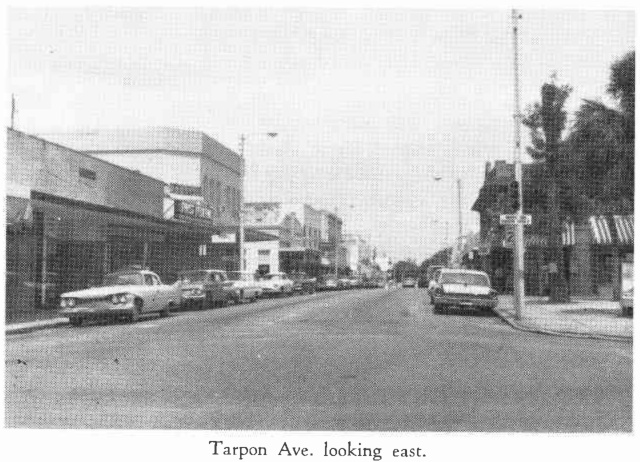 People may wonder how these pioneers fared for food; let me tell you, most of them fared well. It is true that they lacked many of the luxuries we have today, but the substantial food such as beef, fish, pork, poultry, vegetables, wild game, syrup and even sugar from sugar cane, enables a man to cut cord-wood, crossties or work in the field ten hours and sleep like a babe at night. No one ever died of cancer from smoking cigarettes. John, the oldest of the Patterson boys, spent a great deal of his time in the woods; where darkness overtook him, there is where he camped. After building a fire, he lay down and slept on the grass and leaves with his saddle bags for a pillow. He served as game warden for three years. During this time he happened to stop his horse over a rattlesnake; quick as a flash the snake struck, not at the horse, but at his leg, leaving the mark of his fangs on the legging, and that was what saved him. John Patterson and his son, Ezra, were turkey hunting one morning before dawn. Ezra was dozing at the foot of a tree, gun in hand. He opened his eyes to find the head of a snake on a level with his face, his tongue sticking out. With a quick stroke, he knocked it away, probably a large moccasin. CHRIS SWENDSEN A sailor’s life is bold and free, His home is on the rolling sea. And n’eer a life so true and brave, As he who launches o’er the wave. Sailing, sailing, over the bounding main For many a stormy wind shall blow E’er Jack comes home again. Chris Swendsen was born in Jutland, Denmark, February 2, 1896. Though his father was a farmer, Chris became tired of the plow and, like many Scandinavians, decided to cast his fortunes with Neptune. Accordingly, he shipped on a three-master, in 1913, at the age of seventeen, and went to Sweden. This initiation into sea-faring life was not so intriguing, as he was seasick most of the time. Returning to Denmark he decided to try the farm again but the call of the sea was too strong, so Chris launched forth this time for a career which lasted 23 years. His voyages took him to many countries and over many seas. When the First World War was precipitated, Chris was on the high seas. By this time he was becoming well seasoned and salty. While carrying a cargo of 7,000 tons of gasoline from Newport News to Manchester, England, his ship was intercepted by a German submarine and sunk with gunfire. Six men were wounded and one died after they took to the lifeboats. They were picked up by an English boat which carried a small gun. The submarine continued to follow and a running battle ensued. The English boat opened fire with her gun, laid down a smoke screen, and took a zigzag course. The submarine gave up the chase and disappeared. The English boat was hit twice; fore and aft, but no serious damage was done. Chris was taken into Cork, Ireland. A submarine later put into Spain for repairs, possibly hit by the English boat. On June 10, 1917, while on the way from Italy to New York, they were torpedoed by a German submarine. Chris happened to be at the wheel. They again took to the lifeboats. They were taken in to Gibraltar for a while, but later picked up by a cargo ship, bound for the United States with a load of lemons. Chris had the thrill of crawling out on the yard arm of an old square rigger, (wind-jammer) and furling sail. He also was on the water 92 days from Buenos Aires, Argentina to New York on a fourmaster. This was due to the peculiar action of the wind currents at the Equator. Once he was 42 days between Denmark and England, on a brigantine. After many years of experience in both sail and steam, Chris was well qualified to take his place, as a sailor on any vessel. Chris finally drifted into Apalachicola, Florida and after some time, shipped on a deep sea fishing boat. In the course of time he met and married Miss Minnie Woodham. To this union there were born four sons and one daughter, Paul, Herman, Chester, John Carl and Mary Lou. Since Chris Swendsen’s bones were not claimed by Davy Jones’ locker, he decided to leave the sea and settle down on terra firma once more. He came to Tarpon Springs in 1930 and now owns and operates a profitable business on the waterfront at the Sponge Exchange. He is an expert sail and awning maker; he is well known, and respected citizen of this place, and a member of the Church of God. His sons hold positions of responsibility; Paul and Herman in the Victor Chemical Plant; Chester, for the Florida Power Corporation and Pete works with his father. Mary Lou is the wife of Henry Brown, retired, owner and operator of the local Green Gas Company. BAILLIE The Baillies have been briefly mentioned on a previous page; but we wish to say a few more things concerning this large, and well known family. P. K. Baillie has been elaborated on in Tales of West Pasco, by “Uncle Ralph” Bellwood, so we refrain from further comment, only to say that he was the first man to settle at Baillie’s Bluff. To this hardy old Scotchman were born three sons, Bert, John, and William. Also two daughters, Florida and Sue. I knew all of these children. The Baillies were religious people, of Baptist faith, and were good citizens and hard working farmers. Like all of the pioneer settlers, the Baillies automatically became hunters, because of the abundance of game and the need of meat. Some were outstanding, especially Uncle Johnnie, who was a famous deer hunter and guide. In fact, I think most of them could qualify on that line. Uncle Johnnie told me once of guiding a young man who was not experienced in deer hunting. Two deer jumped up in front of them. The young man stood looking at both deer as they ran away and made no attempt to shoot either one. Uncle Johnnie quickly took the gun from his hand and killed one with each barrel before they got out of range. After his hunting days were practically over, the family missed him one day. After a diligent search, they found him in the swamp, down by the river, trying to capture a young bobcat to tame. From this large family it would be difficult to tell the number of grandchildren, great grandchildren and great great grandchildren. There were two Baptist ministers, one county commissioner, one deputy sheriff, mechanics, farmers and fruit growers. All made their contribution to Pasco County, living in the vicinity of Elfers. Our old friend, Willie Baillie, lives on his place, east of Elfers, is a member of the First Baptist Church, and is a retired farmer and hunter. ROBERTS A well known figure around Tarpon and Elfers, at one time, was George Edward Roberts. He first married a young lady at Elfers, Mary Brown, I believe, but she did not live very long, perhaps a year or two. This man, like many of the early settlers, was from the Bahamas West Indies, consequently of English descent. He had a brother, who was a navigator, but never came to these parts that I know of. Mr. Roberts was an excellent cook, and proved his ability many times. He remained single for many years after the death of his first wife, spending most of his time on boats. He would address you as mate; so he became affectionately known as Matie or Cappy. He had charge of my father’s boat and brought most of the shells from the south that were used in the concrete for the base of the Anclote Lighthouse. He was “as one” with our family. After a few years he met a widow from North Carolina and was happily married. He quit the sea and became a painter. He continued to climb ladders until he was over 70 years of age. Then death struck again and his beloved wife was taken away. After some years, he again married a widow from Key West. In later years he became a Christian and joined the Presbyterian Church. I was away from Tarpon, at times for several years, but had the privilege of being with Matie during his declining days. His remains are lying in Cycadia Cemetery, to await the Resurrection. TOM ROBERTS I have taken the time and space to mention some of the boys with whom we were most intimately associated. Two of them happened to be named Tom. Thomas Guthrie, of whom I have already spoken, and Thomas Roberts, of whom I now write. We had much in common, like many boys–and were close companions in many activities, but we were very different in personality. The writer was considered by the townspeople to be the worst. Tom was a jolly, happy-go-lucky kind of boy, never seemed to worry much about things. He was born at Elfers and lived in Tarpon for a few years; his mother moved to Tampa and kept boarding house. Tom remained in Tarpon and lived with John Brown, the city marshal, who was a relative, and at that time, a bachelor. Tom was fond of music and had a birdseye maple guitar, of which he was very fond. He also played the baritone in our local band. His horn was nickel- or silver-plated; all the others were brass. While Tom was living at Elfers, I stayed a few days with him, taking along my 12 gauge shotgun. One day we got into a covey of quail, not far from the house. We fired and reloaded as fast as possible. After getting back to the house, Tom wanted to know how it was that my single-barrel shot like a double-barrel. Tom’s father, like many of the early settlers, came from the Bahamas West Indies, but Tom never seemed to care much for sailing like many of the Tarpon boys. Some time in May, 1898, I became a Christian and joined the Methodist Church; Tom was not favorably impressed with this change in my life and treated it as a joke. Fernald’s Hall, which was in the large brick building, built since the big fire, was the center of many social activities. The boys and men met there to box, dance and have shows of different kinds. One time while Tom was boxing with Jim Hope, he slipped and fell, breaking a bone in his wrist. The floor had been waxed for dancing. Of course, he suffered much pain and sustained a weak wrist for quite a while. Not long after this happened there was a celebration at Port Tampa City and a number of people from Tarpon Springs attended. Tom was among the crowd, and celebrated with the rest. Late that evening, he attempted to catch a freight train to Tampa to spend the night with his mother. Whether it was a weak wrist or too much celebration, no one knows. He missed his hold and fell under the train. He was cut in twain. No one saw the accident, but the depot agent operator heard his groans and he was taken to the hospital. His legs lay on one stretcher and his body on another. Thus we come to the parting of the ways. CRAIG Those who are familiar with the Reader’s Digest will remember “My Most Unforgettable Character,” which appears in many issues. As we travel through life, there is always someone, or even more than one, whom we remember as such. To the people of Tarpon Springs there is one whom we think would qualify in that category. That person is J. N. Craig. Well do I remember him as depot agent for the Atlantic Coast Line Railroad. He was also the mayor of Tarpon Springs. James Newman Craig was born in Lawrenceville, Georgia, July 18, 1865. He died May 18, 1945. He was a graduate of the Georgia Military Academy. In 1887, he went to Hawthorn, Florida, as depot agent for the Florida Southern Railroad. Holding that position until 1895, he went to Micanopy as a depot agent for the Plant System of Railways, staying there until 1907. Then he moved to Tarpon Springs with a family of five children. Newman, who was the oldest, Hal, Helen, Dorothy and Thomas, also Annie Laura, a step-daughter. As station agent for the Atlantic Coast Line Railroad, he was also land agent for the same company. In the thirties, he became mayor of Tarpon Springs and held that office for sixteen years, retiring in 1942 because of the amputation of his leg. 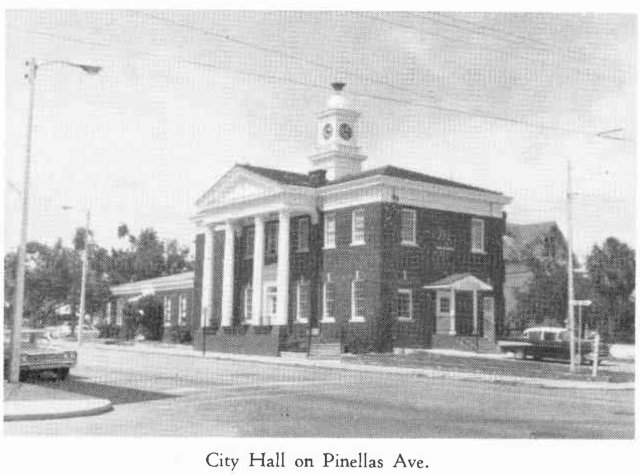 Mr. Craig was an inveterate hunter and loved it, continuing hunting even after his leg was amputated. He never failed to bring back his quota of wild turkey, quail, and game. One incident has been told of him while on a hunting trip to Moon Lake. He was left sitting on a log to call up wild turkeys with his turkey-caller while his companions hunted elsewhere. A flock of turkeys drew near and not being able to reach his gun in the excitement, threw his crutch into the bunch and wounded one. He retrieved his gun and shot it. About an hour later, he called up some more and shot another one. I am indebted to Mr. and Mrs. Newman Craig for the above information. In stalking wild game, he could soon outdistance the average man with those long strides. To say that he was an inveterate hunter expressed it mildly. A man who has the courage to go into the woods on crutches and bring back his quota of game is a nimrod of gigantic proportions. From this family came one postmaster. Hal served until he retired. Thomas served two terms as mayor. Two of the daughters, I believe, were school teachers. Newman is a sponge dealer. To say that Mr. Craig had the confidence of the people is attested by the fact that he served the city as Mayor for sixteen years. That is an outstanding record. GREEN MEYER Green Meyer, the son of Fred Meyer, came with his parents to Anclote when he was a small boy. He led a quiet, unobtrusive life, as a pioneer in the wilderness–hunting, fishing and swimming with his brothers and cousins. When the Spanish-American War came on, Green was employed on public works at Port Tampa City. Desiring to see a little more of the world and get a taste of adventure, he shipped aboard the steamship Florida, which was bound for Cuba with a load of Cuban soldiers. I do not remember her destination, maybe Cien Fuegos. At any rate, when a boatload of soldiers landed, they were ambushed by the Spaniards, who opened fire. A number of soldiers were killed. Also a Cuban officer was killed. Those 28 caliber Mauser bullets punctured the boat also, which began to leak. Green grabbed a pail and began throwing out water. As he was stooping over a bullet struck him in the right temple, and passing through his head, came out of his left shoulder. He was taken aboard with the others and prepared for burial at sea, presumed, of course, that he was dead. To the surprise of everyone, they discovered that he was alive. They immediately gave him treatment, and began nursing him back to health. This metallic boat was rowed by four or six men, one man to the oar. There were no motorboats on this ship; in fact, they were not used much in those days. This situation was saved by a large mulatto, called Red, who sculled the boat out of range with one oar. It was almost a superhuman act; God surely was with Red. I had shipped on this boat, Florida, as a sailor before the mast, but was stricken with the epidemic, then prevalent in Port Tampa, and had to go ashore to wait for the next trip. This trip was to Ponce, Puerto Rico. We were stricken with measles on this trip, but recovered and helped unload the ship. Getting back to Green Meyer; he fully recovered except the loss of one eye. He later married and went into business at Tarpon Springs. During the First World War he went to Jacksonville to work. He finally succumbed to the flu which was raging everywhere at that time. He had one daughter. Just across Boyer Street from our old home stands another old house of about the same age, or possibly a little older, 79 years. It would be hard to determine which house is the worst off for termites, but from outward appearance, they are both in fair condition. BOYER It would be incompatible with the trend of events to close the pages of this book without giving space and special mention to a member of the first family, in the history of Tarpon Springs. D. P. Boyer was born February 16, 1893, at Lime Street where the first settlement was made in this city. As has been mentioned previously, the old Boyer home has been removed. It seems regrettable that nothing remains to mark the spot where Tarpon was born 84 years ago. John Boyer, the father of D. P. (Dee) Boyer was English; his mother, Annie Priemer was German. Dee spent his boyhood days in Tarpon, attending the local schools. April the 19th, 1912, he joined the Navy and served Uncle Sam four years. During that time, he was at Norfolk, Virginia employed in building mines. After serving the Navy, Dee went to Indianapolis, Indiana, where he was employed as a machinist. During this time he met and married Miss Gayle Stapp. To this union was born one daughter, Mary Jane. Incidentally, years later she met and married a man by the name of Boyer. From Indianapolis, Dee went to the “windy city,” Chicago, where he was employed as Chief Machinist’s Mate, at the Naval Station. After a period of time his mind began to wander southward; perhaps a nostalgic urge prompted him to return to his native state. So in 1920 he came back to Tarpon. In 1923 he established an agency for the sale of Chevrolet cars. Later, Nash and Studebaker cars were added. For 25 years he was employed in the automobile business on East Tarpon Avenue. After the automobile company was dissolved, Dee was appointed salt water conservation agent and in this capacity he served the state eight years. At that time the demand for qualified machinists was not great in Tarpon, so Dee went to Miami, where he was employed four years in a machine shop, as machinist in charge. Coming back home, Dee served the city of Tarpon one year as city judge. That Dee was impartial in his decisions, is verified by the fact that he fined himself $10 for striking a man during an argument. It is needless to say that this man was Dee’s friend thereafter. Dee then served on the police force eight years, checking meters. He has retired and lives at 428 East Tarpon Avenue. GRAY I wish to mention, briefly, a family that was connected in many ways with the social, industrial, and commercial life of Tarpon; Mrs. G. W. Fernald, was the oldest and probably the first to come to Tarpon; Mr. Fernald was a merchant, and lost his store during the big fire; Miss Bessie Gray, married W. W. K. Decker, who was a sponge buyer, also a merchant; Miss Etta Gray, married Horace Webster, who was a merchant, and served more than one term as mayor of Tarpon; Miss Nellie Gray, married Mr. McConnell and went away. She returned a few years ago and is now 93 years of age; Miss Mable Gray, who was reputed to be the best on skates of any one in Omaha, Nebraska, went away and never returned. GAUSE In the early days of Tarpon, about 1885, Reuben Gause came from North Carolina, and settled at Wall Springs. After living there a short time, he decided to move into the vicinity east of Salt Lake and Lake Tarpon (Butler). Mr. Gause had seven sons and two daughters. This large family intermarried with men and women in and around Tarpon. That settlement was known as Gauseville. At this writing it would be almost impossible to name, or trace, the children, grandchildren, and great-grandchildren of this large family. The Gauses have contributed their part to the social and industrial life of this growing city. They have participated in various branches of business. Three contractor builders have come from his family: Dock or C. A. Gause, Charlie Gause, and Morris Gause; two painting contractors, Marshal Gause and Walter. Mrs. Grace Kleinfeld, the daughter of Reuben Gause, is supervisor of the Municipal Hospital. Mrs. Rachael Georgiades, a granddaughter of Thomas Gause is a vice president of the First National Bank. Everyone knows Bob Gause, the owner of the Gause Lumber Company. He also served as City Commissioner. Roy Gause whom we consider a special friend, has served as one of the directors of the First National Bank for years and is now executive vice president. Harry Gause, the father of Bob Gause, has served on the school board of Pinellas County for years and has rendered commendable service as maintenance director and has improved the school bus transportation system. Reuben Gause, a son of George Gause, is a retired carpenter. STRICKLAND J. R. Strickland settled at Keystone probably early in the seventies, coming from Georgia. Mr. and Mrs. Strickland had a family of 10 children, six boys and four girls. They were honest, hard-working people and added much to the growing community. Most of the pioneer homes at that time were built of logs as there were very few sawmills in the state and lumber was hard to obtain. Some of the chimneys were made of rock, mortar and sticks, as there were no bricks. Our old homestead had that kind of chimney. Before sawmills and turpentine companies invaded the state, there were thousands of tall, stately pines. Like all pioneers, the Stricklands did their share of hunting. Late one afternoon Mrs. Strickland was returning from an outing in the woods with her husband and stepped into the coils of a rattlesnake, which struck her three times in rapid succession. This injected enough poison into her leg to kill two or three people! Mr. Strickland took some cords from his hunting bag and tightly bound the limb above the wounds. Of course he shot the snake. Then began the fight for her life. There was no hospital in the state, as far as they knew, and the nearest physician was Dr. Edgar at Ozona. Depending upon home remedies, and the mercy of God, her life was saved, and also the life of her unborn child. We saw this child after she was grown to womanhood, a large robust young lady. She later married a man by the name of Youngblood. Mrs. Strickland recovered completely and never seemed to suffer any aftermath from this tragic occurrence. I saw her in Tarpon many years after this, selling produce from the farm. She was handsome, energetic and businesslike. These early settlers were neighborly and would come to the aid of any one in need. In clearing land, harvesting a crop, or even building a log house, the entire neighborhood would turn out and help get the job done. NOBLIT G. E. Noblit came to Tarpon in 1884 and went into business. About 1887 he joined a party of surveyors and was instrumental in getting a right-of-way surveyed through Tarpon for the Orange Belt Railroad. This was a narrow-gauge road, but it was a great asset to this part of the state. Tarpon was the terminal of this road for a while, but later it went on to St. Petersburg. Mr. Doreen, the superintendent of the road, was a Russian and named St. Petersburg after the capitol of Russia at that time. The Orange Belt was bought by the Atlantic Coast Line and changed to a standard gauge. Mr. Noblit further extended his business by operating a grain and feed store and later building and operating a hardware store, both on Safford Avenue. The Peoples’ Hardware was built on Tarpon Avenue in 1906. The City Fathers decided that something must be done to better the condition of main street; accordingly, a track was laid from Safford Avenue to Spring Bayou. Many carloads of clay were dumped on this sandy thoroughfare. This gave Tarpon a hard surfaced street. Brick and other building material were brought in and the rebuilding of the burned-out section was soon under way. The G. W. Fernald building was done in 1894 by Willis Castaing of New Orleans, who was becoming a leading contractor. Charlie Norton, DeLong, J. Harlow and W. D. Wilson were also building contractors. GUTHRIE Dr. Guthrie came to Tarpon Springs from Illinois with his wife and two sons, Thomas and Frank about 1891. Dr. Edgar and Dr. Logan, both non-residents, had served the town at times. Dr. Guthrie was the leading town physician for several years. He also bought two schooners, the Alafia and Sparta and went into the sponge business. Both Tom and Frank were our companions in school and many boyish activities. Frank, the younger, was quite an ingenuous young fellow. I do not remember just all of his inventions, but I do know that he invented a small press and edited a paper called The Messenger. We turned over once while sailing, a sport we both loved, so we tied our shoes to the boat. The craft didn’t sink and we were later picked up by John Boyer. Thomas, my long-time friend, and I had much in common. Especially did we enjoy hunting, target practicing and shooting into the neck of a bottle, knocking out the bottom without breaking it. Once Tom secured his pocketknife as a target and split a bullet on the blade. Spearing tarpon in the bay, with grains, was also a favorite sport. Throwing one another off the bow or stern of the boat gave a variety of amusement. Tom was a good student. He never gave his teacher trouble (like the writer), He also made better grades. Tom was a good machinist, if my memory serves me right. He was a master-mechanic in a machine shop. Tom was the fire chief at this town and served the city in other capacities until his retirement. Tom passed on to his reward January 31, 1963. On February 7, he would have been 85. His widow, Mrs. T. B. Guthrie, resides here. His three sons, Myron, Howard and Thomas, Jr. reside in this state. BENNETT SMITH I am not sure just where Bennett Smith was born, but he made Ozona his home and could be seen around the waterfront and on boats, which was his hobby. He loved boats and the sea so much that he had his picture taken with a coil of rope in his lap. The shallow water at Ozona and the type of boats that dock there never offered great opportunities for a sea-faring life. Bennett did the best he could with the opportunities offered, going on small, coastwise vessels and perhaps waiting for better openings. The lighthouse was always an attractive place for picnics and parties of various kinds. One afternoon a crowd of young people boarded the little schooner, Spasta, and started for the lighthouse, Capt. Bennett Smith in charge. On arriving at the dock, the party disembarked and started for the lighthouse, leaving Bennett to moor, or anchor the boat. Dropping off to deeper water Bennett cast the anchor overboard, not noticing that one foot was in the coil of rope. As the anchor went over the hawser tightened around his ankle, dragging him overboard, and to the bottom. The party continued on, not knowing what had happened. Upon coming back to the boat, they looked, in vain, for Bennett, but he could not be found. Next morning his body was seen, suspended in the water, near the bottom. Thus the sea that he loved so much and the boat from which Dave Hope fell and was drowned, claimed him in early manhood. ALFRED ALLEN I wish to use a little space here to eulogize one of the town boys and band boys, Alfred Allen. Of the background and parentage of this boy, I know very little or nothing. I do know that he came from Arizona and by way of the grapevine, that he was of Mexican and Indian descent. He was brought here by someone and abandoned. Fortunately, he got into the hands of Mother Meres, whose great warm heart gave him a home. Mrs. Meres had no small children or grandchildren at that time and Alfred was just the boy to help her with the many varieties of flowers that she cultivated. Alfred was very young when he was brought here, so in a few years his knowledge of Spanish disappeared. This cast away boy was destined to play quite a part in the field of sports and athletics. Alfred was a leader among the boys. When someone was needed to take the initiative on a risky stunt, Alfred was the boy. He was almost always behind the bat in baseball and when he went to bat, the left fielder always had some activity coming. In boxing, wrestling, jumping, running or just about anything you could mention, it took an all-around boy or man to match that Mexican! Alfred married May Converse, the daughter of the onetime editor of the Tarpon Springs Truth. They moved to Tampa where he finished his earthly career. They had one son, Walter Allen. LANIER G.C. Lanier was born in Waycross, Georgia, March 20, 1889. His father moved to Clearwater when he was a boy, so he had the privilege of growing up in two different states. Returning to Georgia he began to spend the energy of young manhood at various occupations. The good soil of South Georgia is well adapted to farming so he spent some time at this occupation. Desiring to try military life, he served four years in the National Guard. At the age of 32 he met and married Miss Sarah Peddy of Hawkinsville, Georgia. They had one son and one daughter and later five grandchildren. During World War Two, he was inducted into the Army and trained for further military duty, but just as he was preparing to embark for overseas, the Armistice was signed. Mr. Lanier was occupied for a while selling insurance, but his favorite and longtime occupation was mercantile business. He operated a number of stores at various places for over 30 years. His health began to fail, which finally forced him to retire. His residence was at 106 North Levis Avenue, Tarpon Springs. Since this writing he has passed DAVIS In 1903, Frank Simmons Davis came from Taunton, Massachusetts to Tarpon to assist in building the George Clem-son residence, one of the most outstanding buildings in the city. It stands where ex-Governor Safford’s residence once stood, on the north of Spring Boulevard. The spacious rooms and beautifully constructed stairway makes a visit to this house worthwhile. Mr. Hollis is the present owner. Mr. Davis did not return to Massachusetts when this building was completed. During the time he was busily engaged on this job, he became acquainted with Miss Cora Pent, and in year’s time they were happily married. They had seven children, two sons and five daughters, Frank Jr. and Charles, Lucybelle, Grace, Coradean, Ruth and Carolyn. Mr. Davis saw in this “Venice of the South,” a place to spend the remainder of his life. Accordingly, he began to plan for a line of work for which he was so well known; building contractor, construction engineer and cabinet-maker. He soon became well known and was in demand for this line of work. His sons and daughters seemed to partake of his ingenuity and have participated in various branches of efficiency. He passed away, but his widow still resides in this city. VINSON In 1889, L. D. Vinson, the brother of J. M. Vinson, came to Tarpon from Georgia. Mr. Vinson, having an eye for business, soon discovered the potentialities in the climate and scenic beauty of this growing town for a successful business and happy home. He immediately returned to Georgia, sold his possessions, and with his family, came to Tarpon to stay. Most of the stores, previous to this, had been general merchandise with one exception–Mr. Vinson started in with a nice stock of dry goods, perhaps the best up to that time. Chapter 12 Tarpon Springs TodayTruly the handiwork of the Great Creator is shown in beautiful specimens displayed along the Sponge Exchange boulevard. Sea feathers, coral, and shells, and many other wonders of the deep are shown in great profusion. Some of these places of display are Irene’s Gift Shop, Catherine’s Gift Shop, St. Nicholas Curio Store, Florida State Curio Store and Tarpon Springs Curio Store; but perhaps the largest and most widely known commercially is the Tarpon Trading Company of Marine Products on Roosevelt Boulevard. After pedestrians become tired of shopping and sightseeing, there is the famous, nationally known, Pappas Restaurant where they can relax and satiate the desire of any appetite. The Pappas Restaurant is famous for its Greek salad and other good food, including sea food. For those who desire sea food to take home, the Pinellas Sea Food Company, a few yards across the river, furnishes shrimp and other commodities. Johnnie’s Place, east of the Pappas Cafe, is available for hamburgers and short orders. Since I have mentioned places to dine, Tarpon has an abundance of good restaurants and cafes which are available to the public; in addition to those already mentioned is Herme’s Restaurant, 24 N. Pinellas Avenue; Busy Bee Coffee N. Safford Avenue; Charlie’s Place, 525 S. Pinellas Avenue; Chris’ Restaurant, 813 Anclote Boulevard; Fontana’s Soda and Lunch, 247 South Pinellas Avenue; Lenny’s Golden Nugget, Highway 19 North; and the Sunshine Restaurant which serves meals at all hours, has air conditioning, specializes in fried chicken, and is found one-half a mile south of downtown. The riverfront offers more than curios and places to eat. Those who are interested in the method of getting sponge by diving have an opportunity to see how it is done. Boats leave the docks all hours of the day and give an exhibition in the river. Fishing is not the least of Tarpon’s attractions by any means. Boats leave the docks every morning, the weather permitting, for deep-sea fishing in the Gulf of Mexico. The Miss Milwaukee is one of the best known and largest. Then, too, there are a number of places where boats, tackle, and bait can be rented or bought for fishing in the river, bayous, or bay. There are three well known bayous here, all connected with the Anclote River. Spring Bayou, Whitcomb Bayou, and Cramer Bayou. The Gray Gull Dock and Sportsman’s Dock furnish boats and all necessary equipment for fishing. Lake Tarpon, the oldest and best known area for fresh water fishing, furnishes a number of fish camps, of which Cobb’s and C. H. Stetler’s are two of the best known. The fish hatchery on the west side, furnishes fingerlings from which large bass and perch are developed. The numerous bayous, lakes and inland waterways and Gulf, naturally call for marinas, boat-builders, repair shops, and marine ways, of which there are many. The Lake Tarpon Marina is one of the best, located on Highway 19 South. On salt water is the Storm Harbor Marina, West Klosterman Road; Russelo’s Marina, Anclote Road; and Anclote Marina Enterprise, boat builders and repairs, Highway 19, north. And last but not least, an old friend, Janies Turnpaw, on the north side of the river, off Anclote Road. He has owned and operated Marine Ways for perhaps 50 years and knows the “stuff.” James Brady, one of the best boat builders on the West Coast, owns and operates a ways about one-half mile west of Turnpaw, near the Victor Chemical Plant. He will give you efficient service. While mentioning men who have grown up with the city, Leslie Thomas and John A. Thomas are among those who have scored success in the field of building and contracting. They are sons of Mr. and Mrs. J. M. Thomas. My son, Herman F. Pent, married Miss Dorthea Thomas, of the same family. They both are employed in the local postoffice. Concerning the industrial status of Tarpon Springs, the Victor Chemical Plant is a division of the Stauffer Chemical Company. It employs a large number of men and is quite an asset to this part of the state. Within the incorporate limits of Tarpon there are several plants which employ many of the citizens and others out of town and add considerably to the payroll of industry. The ABC Package Machine Corporation and the B. B. Togs Inc. are on the north side, near the river. The Children’s Clothing Company, the Tansey Company, the Manufacturers of Metal Partitions, Diamond Braiding Mills Company, the Shoe Strings and Parachute Cord Company, Gallagher Cotton Toweling Company, Stamas Boat Works, Florida Tanning Company, Avion Foundry Corporation, Tarpon Grinding Company of precision tools, Acme Sponge and Chamois Company, Inc. There are more places of industry on the same level in and around Tarpon Springs. And yet there are opportunities for those who wish to enter fields of enterprise. Truck farming is carried on successfully around Tarpon. A. N. Eady, of North Lake Villa, is the largest and most successful producer of vegetables–cabbage, broccoli, cucumbers, sugar cane and strawberries, which are of the finest quality. Mr. Eady has a beautiful farm with deep wells, which furnish ample irrigation for his crops in all seasons of the year. Tarpon Springs is a delightful place to live, while on vacation or permanently. The economy of the area is predominantly a blend of light industry, residential, sponge and commercial fishing, retail trade, retirees, and tourism. There is a good hospital within the incorporation and easy-to-reach by ambulance. The Anclote Manor, a well equipped sanitarium with a good staff of nurses and doctors, will furnish special care and restoration for the mentally ill and alcoholics. Tarpon has two good funeral homes, both on East Tarpon Avenue, which furnish prompt and sympathetic service. The Vinson Funeral Home has a long record of good service. The North Funeral Home, recently established here, is prompt and efficient. Both give oxygen equipped ambulance service. Of course we are not behind in good drug stores. Baynard, Rexall Drugs, Lane’s Drug Store, and Chris’ Prescription Shop all furnish prescription service. Also with our well-stocked drug stores Tarpon is not lacking in good doctors. Dr. Clough, Dr. Thompson, Dr. Diamandis, and others recently moved in. Two good dentists, Dr. Clark and Dr. Parker, will give you satisfactory service. Tarpon’s first chief asset, as a small village, was the mild balmy atmosphere, so soothing to the nerves, and healing to throat and lungs. Naturally, many invalids came to Tarpon for the restoration of their health, and continue to do so. After the sponge business began to gain momentum and the industrial outlook began to improve, tourists began to seek other places for pleasure and quiet residential abodes. Bat the charm of the Anclote River and scenic Lake Tarpon remained. Now, the tide has long since turned this way again. Ranches and homes dot the banks of the Anclote from the source, which flows through green forests, and provides a home for wild life and game. Toward the mouth of the river, many good building sites remain on high banks, especially on the south side. I was looking at a beautiful place for sale near the home of Dr. Thompson a few days ago on high banks overlooking the river, with dark shell hammock soil. Near this spot is the Turf & Surf Country Club and golf course. The Anclote Manor is about four blocks away. There are miles of riverfront and gulf shoreline, where homes are being built and boat basins and canals are dredged for occupancy. Just east of the city is beautiful Lake Tarpon with its winding shoreline of some 18 miles. There are some bays and many canals and fingers dredged for building convenience. It is possible to have your house so located as to be able to fish out of your back yard, or even off your back porch. While speaking of building houses, I would add that Tarpon Springs has two good lumber yards–The Tarpon Lumber Company, almost in the heart of town, and the Gause Lumber Company, just a few blocks away. Each one will give you prompt and efficient service. LAKE TARPON The waters of the Lake Tarpon furnish opportunities for boating, skiing and fishing. At the southeast end of the lake, Brooker Creek, a good breeding place for small fish, pours its waters in through a forest of beautiful shade trees and affords a fine place to picnic. Alligators no longer dot the waters of the lake, or take their siestas along the shoreline, as they once did. Although the law protects these saurians now the “gator-hunters” take their toll when they feel safe from being apprehended by the game warden. Then, too, when one invades some cracker’s premises in search of hogs or chickens, he is usually lost to the public. There are hundreds of alligators in captivity for exhibition and occasionally you will see one in his native haunts. As has been previously stated, there are numerous fish camps and launching pads along the shores of this beautiful lake. Those who wish to purchase a lot for building or acreage for other purposes, can readily contact a real estate broker. Thomas Craig, who has recently served our city two terms as mayor, is a registered real estate broker. He also sells General Electric appliances at his office on South Pinellas Avenue. H. Joe Smith (Uncle Joe) on South Pinellas Avenue has his office in the Arcade Building. Uncle Joe is well known. He was City Clerk and has for many years sold real state and insurance. Fred Howard, another ex-mayor, is a well known real estate broker. My niece, Mrs. Carl Walker, 61 Canal Drive, Lake Shores Estates, is saleslady for Parsley and Stone. Noblit Insurance Agency, 101 East Tarpon Avenue, is well known in this city. A good supply of city water is available, but should any one desire their own private water system, a good well-driller can be readily obtained by contacting Deep or Shallow Wells, U.S. Highway 19 or Deep or Shallow Wells, 501 East Lemon Street. For those who don’t care to fish, boat ride, or do any thing special, they can find a place to “bat the breeze” and reminisce. The city park is a landscaped public square where idlers or weary shoppers can relax right in the heart of the city. Coburn Park, on the bayou, has tennis courts, shuffle-board courts and children’s playground. The Tourist Club is located here. Swimming and boat launching sites are on nearby Whitcomb Bayou. Rotary Park houses the Youth Center with outside recreational features, baseball diamond, and viewing stand. The Richard Irving State Park, on the north end of Lake Tarpon, is a good place for fishermen and their families on a day of outing. The Tarpon Zoo on Highway 19, South, is stocked with animals, reptiles, and birds from South America and other countries. The Monkey Ranch is on Alternate 19, South. There are probably some alligators there too. Tarpon has another fine golf course of 18 holes just across the road from Municipal Hospital. Those who love reading and research will find that Tarpon has a new public library of 15,000 volumes, located at the Tourist Club. 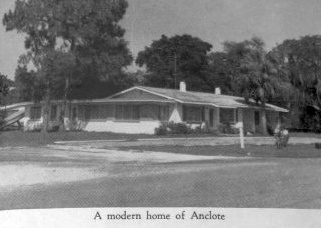 Tarpon’s utility accommodations are numerous and varied, some of which have already been named. The Standard Oil Company, L. E. Ferguson and Leo Denmark, agents and Kerosene Heating Oil agent, George Saclarides, are well known companies, and will give you prompt service. Tarpon Wholesale Plumbing Supply is on Highway 19, north. If you desire information or advice on home painting and decorating, go to George Kaminis’ well stocked paint center, on 17 East Orange Street. There are two well-known hardware stores, People’s Hardware and Burgess Hardware on Tarpon Avenue. The old and well known five and ten cent store is owned by the Harry Jukes family. Also, the Clark five and ten cent store is well known. Both are on Tarpon Avenue. The ever-present sport of fishing has lured hundreds of people to the West Coast of Florida, and at the present date kingfish are plentiful in the Gulf. Last week my son, Herman, took some friends fishing on his boat. They caught 66 Kingfish and two Groupers. Sometimes larger parties beat that but I think 68 fish of that type is a very good catch for two men and a boy. 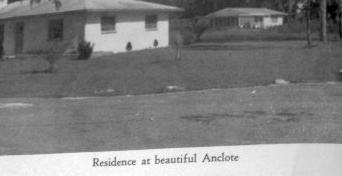 CONCLUSION Returning to the first and much publicized place of this history, Anclote, I must say that after having survived the rigors and handicap of pioneer life, it has developed into a beautiful village. Although not one of the pioneer homes remain, there are many beautiful modern homes dotting the landscape. A nice commodious and modern church offers a haven for those who care to come and worship within its fellowship. Because of proximity to Tarpon Springs and the adequate school bus facilities, it has not been necessary to construct school buildings. Anclote has a thriving commercial fish and shrimp business. Boats can be rented for sport fishing and catching crabs and scallops. The luxuriant vegetation, the beautiful oaks and native palms, especially along the shoreline demonstrates the fertility of the soil. The cool breeze coming in from the Gulf during the hot summer days is refreshing and health-giving. It is a wonderful place to retire and relax. I have endeavored to record these historical and biographical facts as they really were. I am indebted to a few elderly people for helping to confirm certain facts of which I was not certain. My sister, Mrs. Cora Davis, who is 83 years of age remembers many incidents of those bygone days. Some have contributed pictures which are valuable, and which I highly appreciate. Grady Thompson, James Turnpaw, the Chamber of Commerce, Betty Meyer Tongay, and my son, Herman, who has done some excellent work, photographing scenes at Anclote and Tarpon Springs. I appreciate the co-operation and words of encouragement from my wife Jennie Minerva, while writing this history. My sister Mrs. Davis has passed away. We all appreciate the many words of encouragement from friends and relatives as we endeavored to promulgate these facts of the history of Tarpon and its outlying communities. |
